#based on the fact that the role is based on mary as a symbol rather than the role she tried to fill and much less
Explore tagged Tumblr posts
Text
it's really funny to see a post about someone's interpretation of dean with like thousands of notes that i feel like misses several marks regarding his character due to their chronic omission from sam and how sam factors into dean's character/winchester familial dynamics and how it makes dean the tragedy that he is, then when i click on their blog they're a huge lestat fan that doesn't really acknowledge louis. many such cases
#like generally i think the point of dean as mary is the fact that it's an inherently impossible role to fill#based on the fact that the role is based on mary as a symbol rather than the role she tried to fill and much less#the person she actually was. dean could never fill that role and he never did#and the tragedy is the fact that 1) he was given/attempted to fill it in the first place and#2) the fact that he never did fill it but he lost himself in the process anyway#then in the process folding himself into a person that wanted to fill that role + the role he needed to fill in his relationship with john#sam ended up becoming more like the real non-symbol wire mother mary than he ever could almost in a way that feels on behalf of dean#they became mirrored characters!! where's finalgirlwinchester's tags about#both of them being idealists who want to believe in a greater good (2.13 'you know who else had faith like that? - mom')#about both mary and sam choosing to work with the bmol#mary wanting to work with them out of a desire for an endpoint. faith in a better world. that change is possible#no more monsters -> no more hunting -> freedom for her family and everyone else#like that's sam!! cut the head off the snake! (4.12) the light at the end of the tunnel! (8.14)#s12 showed us that sam's tunnel-visioned nature is more mary than it ever could be john#like my favour sam-mary mirror is the captivity room in the bmol base vs the panic room:#taken autonomy for attempts at independence from your role with dean !!#anyway#ludere
11 notes
·
View notes
Text
Oscar and Our Lady of Guadalupe
I've talked a bit about Oscar and his connection to Mary on here, but I figured it would serve best to actually put it together coherently.
Firstly, I must address the fact that, like many of the other people in the Malevolent fandom, see Oscar as Hispanic. Now, you may be saying "Ocelli! How in the world could Oscar be Hispanic? He is very clearly Scottish. Listen to him." yada yada and I hear ya. I hear ya. However, I cannot get the image of it out of my mind and this was before there was a lot of fanart of him out there. However, I do have some mild evidence of this. The Hispanic population in New York is very little in the 1900 area which is about the time we are estimating that Oscar was born. However, it's not zero. Additionally, there is a large percentage of Hispanic people that are Catholic, making Oscar's parents much more likely to have given him to a Catholic orphanage. With such a low population of Hispanics in New York coupled with the spike in racist nationalism occurring at the time due to European immigration, it is very likely that Oscar's family didn't have the means to raise a child. Based on the fact that Oscar never knew his parents, it's most probable that he was dropped off as a baby in which he was still learning how to speak. Therefore, he has a Scottish accent because he learned how to speak from his Scottish caretakers. This also gives reason for Oscar ostracization in the orphanage. Unfortunately...racism. It's assumed that Oscar never got adopted due to his violent act against Father McKenna, but this probably only agitated the motivations of not adopting him due to his race as well. Oscar's role in the church is somewhat in the background. It's assumed that he would run certain masses but based on the amount of availably he had in Season Four, it's probably just to fill in for daily mass. Rather, he focuses on serving the community. He would have been increasingly difficult for him to have been an authority figure in the church, but he fought tooth and nail for it in order to be able to balance out the evil in the magisterium like Father McKenna. This doesn't mean that they'd allow him to do everything he should be able to, hence him being put in the "messy" jobs so to speak. Oscar loves what he does, and he won't ever complain about it nonetheless.
With that explanation out of the way, I'm going to double back to the fact that Oscar NEVER was adopted. He never had a healthy father or mother figure in his life. So, I find it likely that Oscar would lean into Mary and Joseph as his spiritual parents. Think about it. I love the idea that he wears a rosary constantly. Someone once explained to me that holding the rosary was the equivalent of holding Mary's hand. So, Oscar wears a rosary as a symbol of his mom's protection and her watching over him.
Something that only enhances this, is Oscar discovering the appearance of Our Lady of Guadalupe. As Catholics, we believe that there have been multiple appearances of Mary all over the world. One of which (my personal favorite) is Our Lady of Guadalupe. As the story goes, Mary appeared to St. Juan Diego, an Aztec convert to Christianity in the 1500s, four separate times as a woman of mixed Indigenous and European features. She asked for a shrine to be built on the place which she appeared at (Tepeyac Hill) which the bishop of the region hesitated to do. On the fourth appearance, Mary instructed for Juan Diego to gather roses from that hill and bring them to the bishop. These roses were miraculous for two reasons: they were blooming in the middle of winter, and they were native to the bishop's homeland of Castile. When Juan Diego opened his cloak full of roses, an imprint of Mary was revealed to be on the inside of the cloak that we know as the image of Our Lady of Guadalupe. Our Lady of Guadalupe plays a large role in not only Mexico's religion but in its overall history. All that is to say, I think Oscar would find great comfort in not only Mary, but specifically Our Lady of Guadalupe. In the face of persecution, he was able to look up to Our Lady of Guadalupe and St. Juan Diego for guidance and spiritual support (yes, yes, he wasn't canonized until Pope John Paul II but this happened centuries earlier and he would have heard about it. Sue me). Additionally, I’d like to think Oscar picks his birthday to be December 12th, Our Lady of Guadalupe’s Feast Day, in order to share it with his “mom”.
Well! There you go! This is a very important Oscar headcannon to me and I thought you all might appreciate it!
#malevolent#malevolent podcast#oscar malevolent#malevolent oscar#father oscar#fandom faith breakdown
16 notes
·
View notes
Text
Mary Beth Sheridan is my enemy for life
Call-out post for The Washington Post's Latin-America correspondent. Except it's all from this single article she wrote last year about Cuba's Family Code referendum which legalized gay marriage:
Cuba sent gay men to work camps. Now it’s voting on same-sex marriage
That's the title. It gets worse
"It reminds me very much of the debate we had in Canada and the U.S. 10 or 20 years ago, about the role of the family, the role of gay rights," said John Kirk, a Cuba scholar at Dalhousie University in Nova Scotia.
Reality check: Cuba decriminalized homosexuality in 1979, 24 years before the United States. The United States is also the only country who has legalized gay marriage twice. How embarrassing for us.
"The fact that they are asking people what they think about the rights of the minority shows they really don't understand how democracies work," said Juan Pappier
Look, there's absolutely something to be said about how majority rule shouldn't have decisions over minority rights, but not only is that something that's inherent in democracy, but gay rights referendums is something the US has participated in. 3 states legalized same-sex marriage that way. And 17 actually used voting to ban same-sex marriage that way.
What makes Cuba different is the political context. Gay rights activism has been channeled largely through the single-party system, rather than independent civil-society groups, which are restricted. The government has promoted the new law on billboards, at rallies and in official media. President Miguel Díaz-Canel on Thursday urged Cubans in a televised address to vote for the code, tying the balloting to support for the political system.
"Voting 'yes' is saying yes to unity, to the Revolution, to socialism," he said.
Based.
"I understand that the rejection of the dictatorship will prompt many people to want to vote no, reflexively, so that the regime suffers a symbolic defeat," independent journalist Mario Luis Reyes told the news site 14ymedio, run by the Cuban dissident Yoani Sánchez. "But if the 'no' wins, those who will really be defeated are us."
I swear I've seen this same exact discourse in the US surrounding our own elections.
Anyway, fuck you mary beth sheridan. You don't deserve to have your name be a proper noun. You're a common noun now bitch
0 notes
Text
An Essay on Love in Evangelion: 3.0+1.0 Thrice Upon a Time

Evangelion: 3.0+1.0 Thrice Upon a Time is a movie about love in all its forms. From the love of family, friends, and neighbors, to the compassion we feel for people we have never met. The movie reminds us that love is something we continuously gain, lose, and choose, again and again. Which love is greatest? In my opinion, the answer to that question is left up to interpretation. In this essay, I will give my own personal interpretation on certain character interactions and what I believe we are meant to take away from their Rebuild portrayals.
The character I will start with is one I’ve noticed the most outrage over from people who haven’t seen the movie and read out-of-context spoilers: Kaworu Nagisa.
Kaworu is a beloved character among many Evangelion fans, especially those who are members of the LGBT+ community. He is a canonical love interest of Shinji Ikari and I want to reassure people that this final movie does not change that fact. However, it does not make the couple blatantly endgame either. This skirting around the couple might make some fans upset, and while their feelings are completely valid, I do not think they fully understand the difficulties faced by LGBT+ people in Japan, nor do they understand the way that romance is typically conveyed in Japanese storytelling. (I recommend watching “Is ‘Yuri On Ice’ Good Gay Representation?” by James Somerton for more about storytelling nuances.)
What have we been shown about Shinji and Kaworu’s love? The good news is, anything you read into the original TV series and End of Evangelion is completely true for the Rebuilds— because Kaworu is the same Kaworu. This movie proves Evangelion is a single universe set on repeat, and that Kaworu and Shinji meet each other every loop, and in each, Kaworu is trying to make Shinji happy. Within the final movie, Shinji becomes aware of the loops and chooses to break the cycle and free Kaworu from his pain.
What does the relationship between Shinji and Kaworu teach us? I believe the purpose of their love is to show the audience that first, in the words of Kaji, “love has no gender.” Second, I believe Kaworu’s love in particular is a warning about basing your own happiness solely upon another person. There are parallels drawn between Gendo/Yui and Kaworu/Shinji. Gendo could not exist without Yui, and so he was willing to destroy the world to be reunited with her. For Kaworu, it was not the destruction of humanity, but the destruction of himself that defined his tragedy. What’s important within the final movie, in my opinion, is that Shinji does not reject Kaworu’s love. With the insight he’s gained from remembering past loops, he sees Kaworu’s love and appreciates him, but he also sees his suffering and wants to ease it. He helps Kaworu into a new world where he can seek his own happiness and find balance in his life (something his father did not have).
While Kaworu and Shinji are not seen as an explicit couple at the end of the movie, it’s significant to note that, when he sets Kaworu free, Shinji holds out his hand to Kaworu as a promise to stay together. Over the course of the movie, Shinji comes to accept his connection to others through accepting touch (in the form of hand holding and hugs from Rei, Misato, and Gendo); however, Kaworu is the only character in the movie who Shinji initiates physical contact with and that speaks to how much Kaworu means to him. This simple gesture, in my opinion, keeps the door open for Kaworu and Shinji to be a couple one day, after Kaworu has found more balance in his life.
If I were to write an entire essay about Kaworu, it would be titled, “Out of the Coffin: How the Resurrection of Kaworu Nagisa Buries the Tragic Lovers Trope” because this movie truly does just that.
Another potential love interest for Shinji for many years was Asuka; however, unlike with Kaworu, the nature of this relationship is not left up to interpretation by the end of the movie. Before her big final battle, Asuka tells Shinji, “I think I loved you back then” (regarding their time in middle school) and Shinji, during Instrumentality, tells Asuka, “Thank you for saying you loved me. I loved you too.” It is past tense.
What does this relationship teach us? It’s a beautiful way of showing that we can love people, and grow and learn, and let go when we no longer fit each other. Letting go is an integral part of life. Whereas other Instrumentality scenes involve touch, Asuka’s, mirroring the ending of End of Evangelion, has a distinct lack of touch. Shinji sits with his arms around his knees and Asuka turns her body away from him. He gives her his thanks and he sends her off to find her peace. Asuka and Shinji teach us that it’s okay to grow out of relationships. You can appreciate what they were to you at the time they happened and move on.
What about Rei? To be honest with you, this movie is less about Rei’s relationship with Shinji, and more about her relationship with the world. Rei teaches movie viewers about the simple pleasures of living. While Shinji is in mourning for the first quarter of the movie, Rei (as “Sokkuri”) is learning about crop growing and community, the wonder of babies and kittens, the joy of the bath after a long day of fruitful work, and the power of words and picture books. At the end of her life, she only regrets not having more time to spend with the people she loves. In Instrumentality, Shinji accepts her hand when it is offered to him, which I hope signifies he is ready to see life as she had come to during the final movie.
Rei teaches us that we can love living and to not take our limited time for granted.
Next, we move on to parent figures: Gendo and Misato. I think they both represent people ill suited to the role, who do the best they can despite it. Gendo, as mentioned for Kaworu above, is a warning about defining yourself by your relationship to another person (Ikari, afterall, is Yui’s name). He is also a lesson in how people mourn and how they can lash out. Misato, like Gendo, felt herself a poor parent, and while mourning the loss of Kaji, she gave up her child to be raised by other people, but, unlike Gendo, went forward to put all her energy into protecting humanity. Both of them reach out to hug Shinji within the movie and he accepts them where they are.
While I wouldn’t say the movie shows that Shinji forgives Gendo, it does show his making an effort to understand and make peace with what others have done. For Misato, it is fair to say we can still hope for a better future, even when it feels like everything is crumbling around us. Her self-sacrificing love for her son and the whole of humanity is what enables Shinji to then save the people he loves (via the spear of Gaius).
In the movie, we are also shown friendship. Touji, Hikari, and Kensuke are important members of their community who maintain open communication with those around them and respect others’ boundaries. They are patient and kind and represent the importance of being present. They teach us to meet people where they are and support them how we can, whether it’s giving them a warm meal or giving them space when they need it.
There are many more characters that could be talked about, but today I am going to end on Mari. Mari’s love is physical. She enjoys being in people’s personal bubbles. She cuddles Asuka and helps trim her hair, she gets into Gendo’s space at college, and at the end of the movie, she reaches out her hand to Shinji to help him stand up from his seat. Upon first glance, some viewers might take Mari and Shinji’s final scene to be romantic, but the reality of it is this: We do not, and cannot, know what kind of love she is meant to represent in his life.
We do not know Mari’s relationship with Shinji because they hardly interact in the movie. She clearly cares about him, but in my opinion, it comes from a place of duty and compassion— Mari was friends with Gendo and Yui. She has been there since he was born. (If we take the manga to be canon, then Mari even had romantic feelings towards his mother. Her hairstyle and glasses are from Yui. At the end of the movie, Mari has changed her hairstyle, which to me implies she has moved on, and “getting” with Shinji would be a thematic break.)
Additionally, their conversation, while flirty, is very much one that implies they haven’t seen each other for a while. Mari is someone who is very physically affectionate. With everyone. If someone ignores that and focuses on the fact she gets into Shinji’s space and claims that’s romantic, they better acknowledge it’s possibly romantic with Asuka, who we see far more intimacy with. When Mari flirts, Shinji flirts back and her initial reaction is surprise, “Wow, you’ve learned to talk back!” Her purpose is clear. She is there to remove the DSS choker from his neck.
Personally, I love that Mari is the one to close the movie, for the exact reason that we do not know her relationship with Shinji. For Mari to have an assigned role would be to say, “This kind of love is most important,” when the entire movie was spent showing us each love is of equal importance in the balance and building of our lives. (It’s wonderful to see those types of love embodied across the platform from Shinji at the end of the movie: Rei and Kaworu, who, just like in End of Evangelion, could signify the ability to connect with others and be loved.)
If you view Mari as a romantic love interest, then I think it speaks to the value that you as an individual give to romance rather than what the characters themselves are feeling. To me, Mari, the character who was created to “destroy Eva,” is a symbol of all love. When Shinji takes her offered hand and then pulls her to run into the new world, it’s a symbol of balance. The give and take of any kind of relationship.
We are the product of every relationship we have ever had, from our parents to the people we once loved, from our friendships to any other person we want to stay connected to. Evangelion: 3.0+1.0 Thrice Upon a Time is a story about these relationships. It is a story about love.
#rebuild of evangelion#kaworu nagisa#shinji ikari#asuka shikinami#mari makinami#rei ayanami#misato katsuragi#gendo ikari#thrice upon a time#kawoshin#essay#movie review#shinkawo
471 notes
·
View notes
Text
Pride Month special: Manzat, the deified rainbow and her LGBT connection

Considering June is the Pride Month, I've decided to dedicate this month's first article to a rainbow-related topic too. Below the cut you can learn everything there is to know about the Mesopotamian goddess of the rainbow, Manzat (also spelled Mazziat, Manziat, Mazzet etc.) - her origin, role ascribed to her by ancient authors, associated deities and more. As promised by the title, the final section of the article deals with a text mentioning Manzat, which is, as far as I can tell, the oldest documented association between the rainbow and LGBT themes.
Manzat isn't exactly an A list goddess. Even calling her a B list one would be a stretch. Indeed, she's so obscure that we know more about many attendant deities than about her. She nonetheless is attested in many different sources, found in areas between the ancient states of Mari (in present day Syria) and Elam (in present day Iran). Manzat most likely has her origin among Akkadians in ancient Mesopotamia. Her name is pretty self explanatory – if written without the symbol known as “divine determinative” in front of it, it's simply the Akkadian term for the regular rainbow. While a Sumerian form of the name is known as well – Tir-anna (“Bow of heaven”) – the fact it appears to be a pun based on Akkadian homonyms (the sign used to write “Tir”means “forest” in Sumerian but was pronounced close to the Akkadian word for bow leading to such an usage in some Sumerian texts) makes it unlikely it arose naturally.
Between Elam and Mesopotamia
Curiously, it seems that despite Akkadian origin she was actually most popular in Elam, to the east of the Tigris. The first mention of her known today comes from the treaty of Naram-sin, king of Sumer and Akkad, with an unspecified ruler of a part of Elam, where she appears among the deities serving as its witnesses, alongside the crème de la crème of the Elamite pantheon – Pinikir, Humban (likely a “king of the gods” figure like Mesopotamian Enlil, venerated well into Persian times when parallels can be drawn about the cults of him and “Auramazda” - an early, not necessarily fully Zoroastrian form of Ahura Mazda), Inshushinak (the tutelary god of Susa who judged the dead) and so on. It needs to be pointed out that Manzat's “career” in Elam isn't a unique situation. While the Elamite language wasn't related to Sumerian or Akkadian – or to any other known language, living or extinct, for that matter – a number of Elamite gods have names borrowed from these two languages. In addition to Manzat, these include Lagamal (Akkadian - “no mercy,” an underworld deity), Ishmekarab (Akkadian - “hears the prayer,” a law deity) and Inshushinak (Sumerian - “Lord of Susa,” associated with both Lagamal and Ishmekarab). All of them appear in Mesopotamian texts too, but didn't have quite the same relevance there as in Elam. In turn the Elamite god Simut was adopted by the Mesopotamians as a personification of Mars and the goddess Pinikir became somewhat of an international sensation, showing up as far as west as in Anatolia, for example in the Hittite Yazilikaya sanctuary, possibly as a personification of Venus. While early researchers viewed Pinikir as a mother goddess, and this claim still shows up here and there today, renowned experts such as hittitologist Gary Beckman and archaeologist Kamyar Abdi, who studied this goddess in depth, demonstrated she was instead an “Ishtar type” deity. It's also possible the god Tishpak has his roots in Elam, though some scholars instead see him as a reflection of the Hurrian weather god Teshub instead.
The worship of Manzat
Sadly, there are no known myths about Manzat. What little we know about her comes mostly from sources concerned more with cultic than mythical affairs. For example records show that Manzat was reasonably popular as a deity invoked in theophoric names, both Akkadian and Elamite. Examples include Manzat-ili (“Manzat is my god”), Manzat-ummi (“Manzat is my mother”) and “Danum-Manzat” (“Manzat is mighty”). A number of shrines and temples of Manzat are recorded: in Mesopotamia in Nippur and Babylon (four shrines in that city alone), and in Elam in Susa, Hubshen ( present day Deh-e Now) and as a part of the famous Choga Zanbil site (the first photo in this article is a modern reconstruction). It seems in Elam she was often worshiped alongside the already mentioned Simut, and some researchers propose they were a couple; evidence from the Mesopotamian city of Der appears to indicate she was viewed as the wife of the local head god Ishtaran (no relation to Ishtar) there. However, the god list An-Anum doesn't list any husband in its brief Manzat section – only an otherwise completely unknown son, Lugalgidda, and a sukkal (vizier, second in comman), Sililitum. Sililitum's name is Akkadian, but appears to be the name of a month in the Elamite calendar as well. Ishtaran has no wife in this god lists, and some sources simply call his spouse “Šarrat-Der(i)” - “queen of Der.” One curious Elamite inscription refers to Manzat as “Manzat-Ishtar” - this doesn't necessarily indicate a conflation between her and the superstar of Mesopotamian mythology, though. It's possible that in this case “Ishtar” means an ishtar without the capital I: in some text, “ishtar” is a generic term for goddesses, not even necessarily of the “Ishtar type.” Examples of such usage of this term can even be found in Epic of Gilgamesh (tablet XI). No other sources associate Manzat directly with Ishtar – the latter's Elamite equivalent was Pinikir; as I’ll demonstrate later she was associated with another “Ishtar type” goddess though. It's possible that a goddess hiding behind the Akkadian title “Belet Ali” - “lady of the city” - was one and the same as Manzat. The fact that the enigmatic “Belet Ali” was associated with Simut in Elam strengthens this impression. A number of epithets are attested in god lists, among them “Lady of the regulations of heaven,” “Companion of heaven” and “She who makes the city flourish.” Almost all of them highlight her nature as a celestial deity.
Astronomical role
Manzat's Sumerian name Tiranna – but seemingly not her Akkadian name – was also used to refer to an unidentified star. According to Gods, Demons and Symbols of Ancient Mesopotamia: An Illustrated Dictionary by J. Black and A. Green (p. 153, the Rainbow entry) horse head under a “gate” symbol present on some kudurru (Mesopotamian border markers) represents this star, but I can't find this claim anywhere else.

The horse head symbol on a kudurru (British Museum)
Manzat, Nanaya and the promised LGBT themes
While this is technically almost all there is to know about Manzat, the story doesn't end here. As I promised, I will now introduce a text which associated the rainbow – well, Manzat, to be specific, rather than the general idea of rainbows, but the point stands – with broadly understood LGBT themes. The discussed text is a hymn to the goddess Nanaya. Nanaya was either a hyposthasis of Inanna/Ishtar, part of her entourage, or an independent but similar deity, and was first and foremost a goddess of love, including its corporeal and sensual aspect. In some hymns Inanna/Ishtar “tutored” Nanaya.
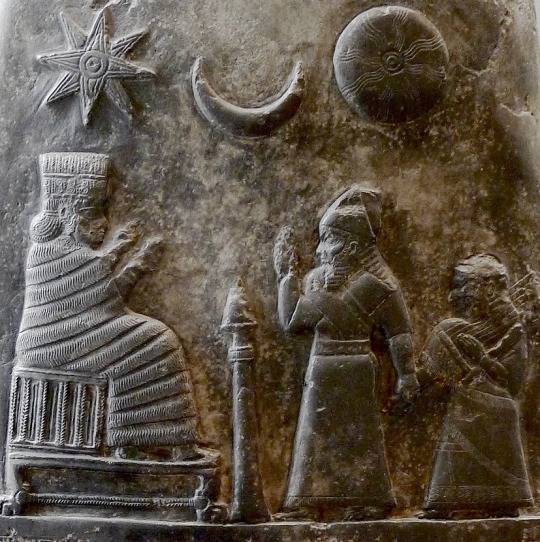
King Meli-Shipak and his daughter praying to Nanaya on a kudurru (wikimedia commons)
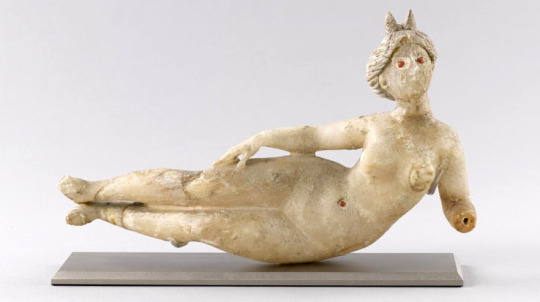
A reclining goddess, identified as a possible late depiction of Nanaya here (Louvre) The composition in mention a type of exaltation, praising the author's deity of choice by comparing their attributes to these of other gods. In the case of exaltation texts dedicated to Marduk this is often erroneously viewed as “monotheism” in sources of dubious quality, but that's not quite what's happening there. The purpose of such texts was to present the object of personal devotion as particularly grand and significant in the divine hierarchy by comparing their traits to these of other gods (eg. at mot henotheism, not monotheism); they are also not exclusive to Marduk, and they don't deny the existence of a multitude of gods (the famous Marduk exaltation still mentions his wife Sarpanit independently for example) According to the discussed tex Nanaya, to put it colloquially, swings both ways:

This passage was identified as referring to sexual matters already in the 1970s (A Sumero-Akkadian Hymn of Nanâ by E. Reiner, p. 233-234; the article is somewhat dated but a link can nonetheless be found in the bibliography). In an earlier strophe Nanaya states that she can take a male form (as a side note Reiner regards the form with “heavy breasts” as unusual for her):

While exaltation of a specific deity could include both gods and goddesses as their “aspects” (exaltation of Marduk included the goddess of victory Irnina among deities compared to him), in this case the mention of a bearded god is connected to a certain degree of fluidity of gender associated with many “Ishtar type” goddesses, especially with the Hurrian Shaushka. For Nanaya it's pretty uncommon, as far as I know appearing only in this single extraordinary text, and even here a result of association with her more famous “mentor” Ishtar – but the point stands. In the rest of the hymn, goddesses Nanaya identifies herself with are enumerated. These include all the usual suspects (like various forms of Ishtar, important city goddesses, etc.), but also Manzat, here identified as the goddess of Der. Since the text describes Nanaya as – if you squint - interested in both men and women and perhaps genderfluid, it's pretty safe to say this is the oldest recorded association between the rainbow and lgbt themes, even though it has nothing to do with modern use of this symbol. If nothing else, it would be funny to bring this up next time someone claims the use of rainbow as a symbol of the LGBT community is “inappropriate” due to its biblical connotations – Manzat and Nanaya, while irrelevant today even by the standards of Mesopotamian deities, are after all figures of even greater antiquity. Happy Pride Month, everyone.
Bibliography
Manziʾat entry in Reallexikon der Assyriologie und vorderasiatischen Archäologie by W. G. Lambert is the source of most of the information in this article
Goddesses in Context: On Divine Powers, Roles, Relationships and Gender in Mesopotamian Textual and Visual Sources by J. M. Asher-Greve and J. G. Westenholz
Gods, Demons and Symbols of Ancient Mesopotamia: An Illustrated Dictionary by J. Black and A. Green
The Other Gods who are: Studies in Elamite-Iranian Acculturation Based on the Persepolis Fortification Texts by W. F. M. Henkelman
Elamite Temple Building by D. T. Potts
A Sumero-Akkadian Hymn of Nanâ by E. Reiner
Elamite Religion in Encyclopaeda Iranica
For more sources regarding Nanaya, other “Ishtar type” goddesses and their possible genderfluid character see my previous articles here, here and here.
134 notes
·
View notes
Text
Toga Himiko’s Normal Life
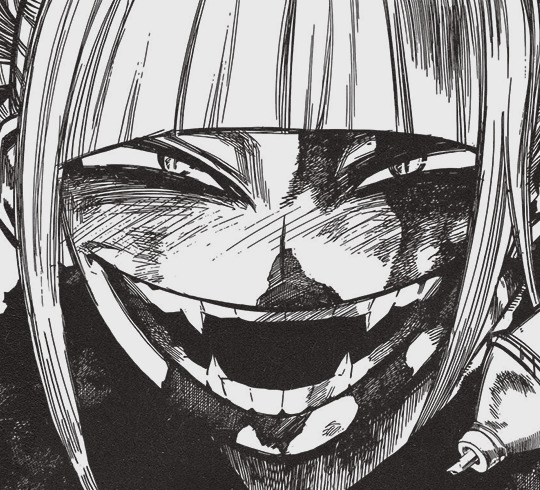
Himiko looks like the most straight forward case of what pop culutre considers to be a classical sociopath / psychopath in My Hero Acadmia. Shigaraki, Dabi, Hawks were all groomed to become the way they were, but Himiko possessed a natural inclination towards blood and violence from the start. She seesm to be a natural born cold blooded killer, however in this meta I’ll argue that while Toga seems like the flip-side of a normal, good person like Uraraka, she’s actually just a normal girl herself.
1. Character Origins
Volume sixteen of My Hero Academia had an official illustration included as an extra that shows the characters Twice and Himiko drawn together in an illusion to a famous Joker and Harley Quinn illustration.
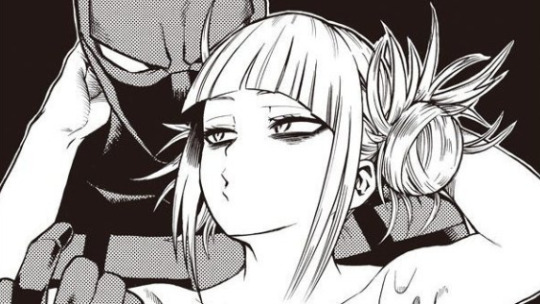
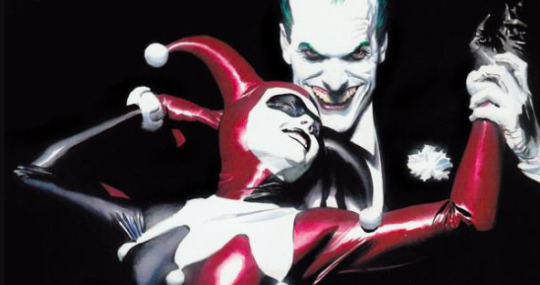
Now, I’m not going so far as to claim Himiko was based off of Harley Quinn, but one the league of villains and characters like Twice (and ReDestro) have made similiar references to the Joker before that especially with the quote “All it takes is one bad day”. There’s also enough similarities betweeen the two characters, they’re both the only female members of a crime syndicate that is mostly men, and dominated by men. Their backstories mirror each other, they were both relatively sane, normal, girls, until suddenly they cracked one day and became a total inversion of their previous presonality. There are enough similarities that I could use Harley as an example to explain a few of the important ideas present in Toga’s character.
They are also both female characters who are written with love as the central concept of their characters. Harley’s origin as originally depicted in the comic and episode for the Batman the Animated Series “Mad Love” goes as follows: Harleen Quinzell was a psychiatrist working at Arkham. Eventualy she came to sympathize with one of her patients which triggered a transformation in her from well meaning doctor, to love-sick sycophant of the joker who broke him out of prison.
A lot of Batman Villains have origins like this. The most comparable one is Harvey Dent. Proescutors, Doctors, we are told the people who hold these jobs are good and righteous people. Even Harley herself started out as someone who just sympathized with a patient too much. However, somehow they become flipped into the exact opposite versions of themselves. They go mad for lack of a better words. Harvey Dent who was once a symbol of justice, becomes nothing more than a murderer, and Harley Quinn goes from healer to the sidekick of a mad clown willing to destroy everything in the name of love.
The question, asked in both Himiko and Harley’s stories is how can good people flip like this?
Most people have a black and white view of these issues: good people are only capable of good actions, and bad people are capable of bad actions. It’s hard to swallow the fact that any normal person has the capacity to cause so much harm inside of them.
We see similiar remarks in the background of Himiko’s story. Himiko comes from a good upper class family, she went to what was most likely a good school, she was always smiling and surrounded by friends. Everyone who comments on her sudden transformation reacts in a similiar way. “She was aways so cheerful and well-behaved, I still find it hard to believe.” She was always such a good girl, and good people don’t do those things.

Normal people, good people, don’t have the capacity to do bad. That’s what makes the transformations so shocking. Therapists/Doctors are supposed to heal, Prosecutors are supposed to be just. And now we return to our old friend Jung.
The story of Harleen Quinzell and Harley Quinn. The story of Himiko Toga the happy middle school girl and Himiko Toga the serial killer is a tale told over and over again, it’s just usually told with male protagonists instead of female ones. It’s Dr. Jekyll and Mr. Hyde.
Robert Louis Stevenson’s The Strange Case of Dr Jekyll and Mr Hyde (1886) is a late-Victorian variation on ideas first raised in Mary Shelley’s Frankenstein (1818). Stevenson’s monster, however, is not artificially created from stitched-together body parts, but rather emerges fully formed from the dark side of the human personality. In the story Dr Jekyll, an admired member of the professional Victorian middle-classes, conducts a series of scientific experiments which unleash from his own psyche the ‘bestial’ and ‘ape-like’ Mr Hyde (ch. 10). Gothic fiction had examined the idea of the sinister alter ego or double before on many occasions but Stevenson’s genius with Jekyll and Hyde was to show the dual nature not only of one man but also of society in general.
“Man is not one, but truly two.”
Robert Louis Stevenson
Both cases are tales are transformation, of the monster coming from within. Himiko transforms from middle school girl into serial killer. Harleen Quinzell transforms into Harley Quinn. Dr. Jekyll becomes Mr. Hyde. We witness a transformation into a monster that seems the antithesis of everything that person was boefre, but was inside of them all along this works because of the jungian idea of the shadow.
The shadow is the unconscious side of personality. The shadow is what exists but what we do not acknowledge. If our behavior during everyday life, choosing to smile, choosing to talk to people, choosing to use our manners is a mask then the shadow is the face beyond the mask. The conscious personality conceals, the shadow reveals. It’s the difference betewen who we are and who we choose to be. The shadow isn’t necessarily negative however. The shadow is just the repressed side of our personalities, it’s what we try to hide.
The shadow plays a role in Harleen’s transformation. While it’s present in Mad Love as well, a recent miniseries ‘Harleen’ really dives into the Jungian symbolism. There’s even several similarities in common with Himiko’s story, for example there’s a scene where Harleen is shown watching the bat man beat up joker and notice how everyone is cheering despite the fact that it’s violent.


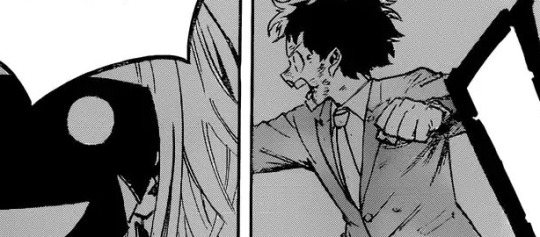
Himiko’s interest in a boy is sparked by watching him get into a fight while everybody else is cheering for him.
The cover page depicts the change between Quinn and Quinnzel as a crumbling mask, which is the exact same imagery used for Himiko.
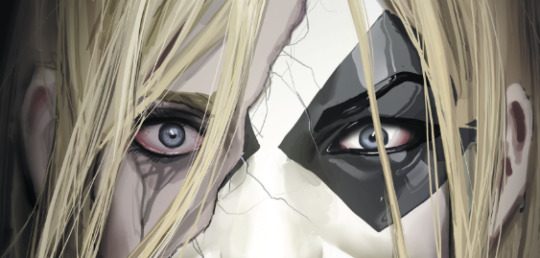

When she enters Arkham she chooses to depict Harley Quinn’s silhouette in Harleen’s shadow. Once again implying that the transformation is not so sudden and jarring as it seems, that Harley Quinn has always been there and is a part of her psychology the same way Mr. Hyde is inside Dr. Jekyll.
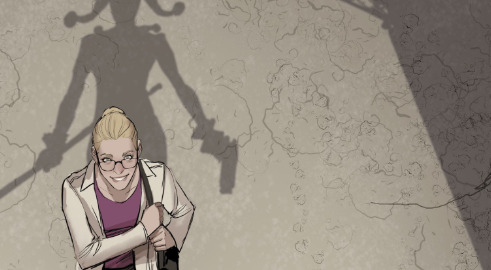
The comic even points it out. Harleen, and also by extension Harvey Dent are people who claim to be “good, righteous people’ and yet both of them end up transforming into murderers. Two-face’s name is literally two-face.

There’s also one particularly Jungian sequence in the middle of the conflict. She dreams (dreams are unconscious and therefore the realm of the shadow in Jung’s theories) about the city of gotham as a place inhabited with citizens who are monsters wearing the faces of human beings.
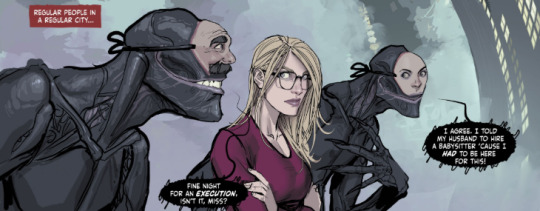
The idea is consistent throughout that Harleen is not really a ‘good person’ she’s merely repressed. She has had this capacity to be violent inside of her, this selfishness, all of these dark desires carried with her all along but rather than deal with them in any healthy way she repressed them until repressing them is no longer an option. Harvey Dent’s face gets half burned off, Harley’s skinn gets bleached by chemicals, the monsterous features inside of them are now worn on their faces and they have to wear their ugliness on the outside rather than the inside. They are now expressing every single thing they have repressed. However, the suggestion in both stories is that these are not special cases, that Gotham is such a repressed society that everyone is repressing the things they don’t like about themselves in that way. Harley fell in mad love sure, but love was just the reason, just the trigger, the truth is those feelings always lurked inside of her and she had no healthy way of dealing with them before that point.
That is the shadow, it’s everything you repress but it never disappears. If you ignore it, it takes on a life of its own. In some cases, like Harley’s you basically become your own shadow. Harley is the flipped upside down version of Harleen Quinzel, now her inner demons are what are expressed on the surface (desperation to be loved, violence, etc.) while her ‘normal’ self is hidden under a mask of insanity. That’s in fact how she ends the comic, Harley qalking around while Harley is trapped on the other side of the mirror because they have basically traded places. Now Mr. Hyde is walking around, while Dr. Jekyll is hidden personality. But it’s important to remember it’s not something like a split personality, Harleen Quinzell and Harley Quinn were always two sides of the same person. Even when she starts expressing her ‘bad’ traits, the good traits don’t go away. They’re just hidden underneath the surface the way the repressed bad traits used to be. Because you’re not good or bad, you’re not one side or the other. You’re both at the same time. Man is not one, but truly two.
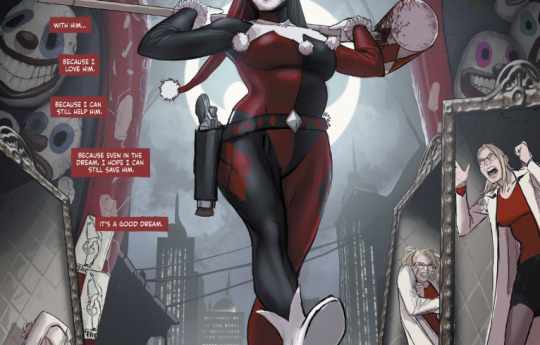
So the complexity in Himiko comes from understanding that she’s BOTH a normal girl, and also a blood crazy yandere psycho.
2. A Normal Girl - Uraraka Ochaco
Uraraka is a pretty standard shonen heroine. She’s a cheerful girl. She’s a supportive friend. She’s the embodiment of what you’d call a good, kind, person and doesn’t seem to be any more complex than that. She lacks say the drive to be a hero that Midoriya does, the superiority complex that Bakugo has, the emotional issues that Todoroki has. She seems to always be agreeable and in a cheerful mood.
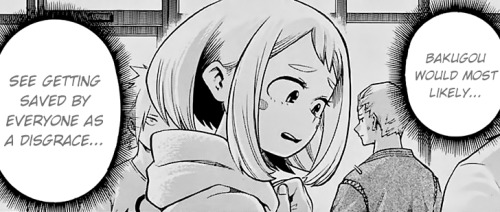
If you look just a little bit closer though she always seems to be walking on eggshells when she’s around others. She doesn’t want to join Deku and the others to try to save Bakugo from the heroes because, it might hurt Bakugo’s feelings.
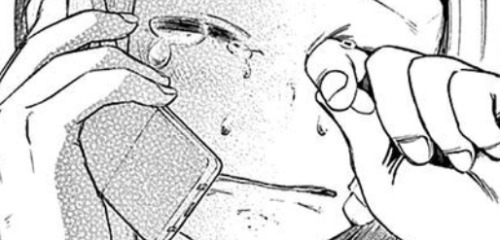
When she loses in the hero tournament, she apologizes to her parents crying not because she feels bad that she lost, but she feels like she failed them. Like it was her job to win and bring money home. However, when Deku comes to check on her in the room she’s already completely hidden her tears.

Going into her backstory we learn that Uraraka is walking on eggshells around everybody due to her own parents, that she’s spent her life trying to be as small of a burden on them as possible because she could see the tired looks on their faces. She’s a child who felt guilty that her parents had to take care of her.
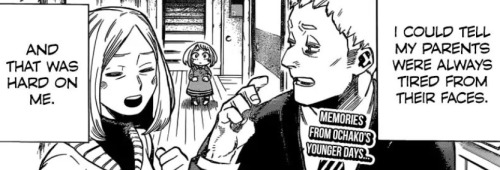
So, for Uraraka her entire life is devoted to making herself seem as small and inconsequential as possible. Other people’s needs will always trump hers. Other people will always have more noble motivations for becoming a hero than she has. Other people’s emotions will always be louder and take priority over hers. Uraraka sees her own emotions and needs as mere trifles that get in the way, and so she always shuts them down. We see Uraraka as a version of Himiko, a high school girl who always appears to be cheerful and well-behaved but is merely repressed.

Uraraka repeats the same unhealthy behavior as Himiko once did. Which is why Uraraka’s first meeting with Himiko goes with Himiko getting such a cold read on her.
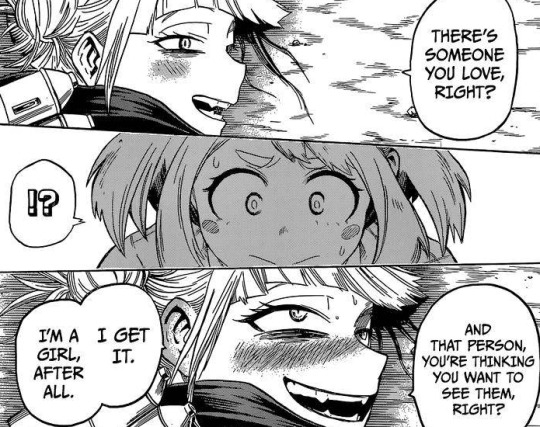
It’s helpful to view Himiko as the flipped version of Uraraka. Uraraka hides everything that’s pleasant about her on the inside, and on the outside appears like a perfectly selfless girl. Himiko is someone who hides her good qualities and instead wears the mask of a bloodthirsty psycho on the outside. While Uraraka lives by denying her selfish desires, Himiko always chases after them and is true to them.
Traits that are repressed in Uraraka, are expressed in Himiko. Especially traits that society sees as bad in girls, like selfishness, being emotional, etc..
The way Himiko acts is especially jarring because she seems convinced she’s a normal person. She’s in her own little world, making friends, getting along with other people, it’s just her friendship just happens to involve stabbing.
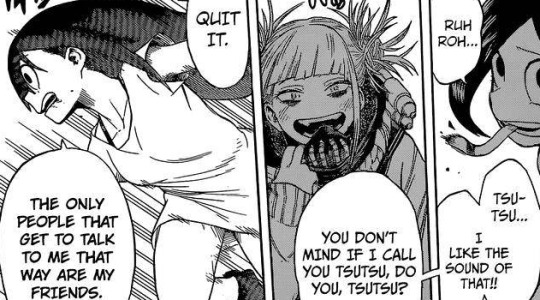


Himiko appears to be a girl psychotically obsessed with blood and nothing else. A girl who only cares about killing other people and chopping them up to bits. When she expresses the feelings deep inside of herself, literally no one can make heads or tails of what she’s saying, she doesn’t sound like a girl just a bloodthirsty monster.


While Uraraka seems like she has nothing in common with what is essentially a weird serial killer, we learn that the exact behavior that Uraraka’s creation is what led to Himiko’s current state of mind.
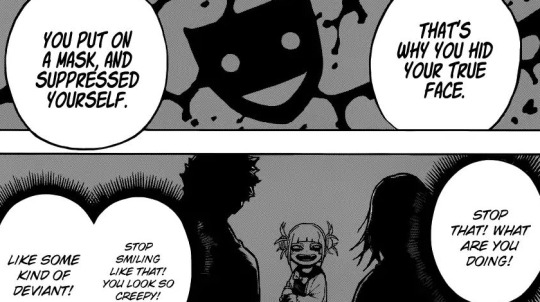
The difference between them is not that Uraraka is a person of higher moral character, or a better person, but rather of circumstances between the two of them. It’s not the choices they made but rather things they were born into and couldn’t control. Uraraka has parents that accept her even when she fails and encourage her.
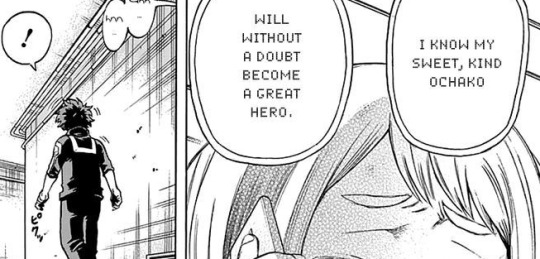
Toga had parents that abused their daughter, and then abandoned her.


Uraraka chose to repress herself, while Toga was forced to become repressed by her parents. While we don’t know for sure if it was physical abuse it’s at least emotional abuse, and it had to be to an extreme extent to make Himiko snap that hard. The same unhealthy behavior but push to extremes gets extreme results.
3. Normal Girl - Himiko Toga
Himiko did not become the way she is because she was lacking empathy or born with uncontrollable urges for bloodlust, but because of the environment around her that always forced her to repress herself. From the knowledge that her parents would never love her for who she really was. Himiko wasn’t born that way she was a response of what was done to her.

People who don’t really know Himiko always judge her this way, that she’s incapable of understanding other people, that she has no empathy for others. She’s almost literally labelled and dismissed as a one dimmensional yandere trope by the people surrounding her.
However, Himiko is in fact always doing the opposite. She’s constantly trying to empathize with others. Her maddened way of talking to both Tsuyu and Uraraka in her character introduction is exactly that, her trying to feel that kind of connection.
Himiko’s fascination for Uraraka is a desire for empathy and understanding. One that you could say even surpasses some characters on the hero’s side, because she’s willing to try to understand the world’s of people who are nothing like her. Himiko’s next most significant action in the manga is to take Camie’s place and go after the kids. While she does fight against them she’s not overly violent, just curious. Deku even reaffirms some of Himiko’s primary traits.

Himiko is always talking a lot and trying to explain her way of thinking to other people, because she wants them to understand her. However, because she’s bad at communicating this tends to come off as babble and a lot of people completely dismiss what she says and don’t attempt to listen.

She expresses two things one a desire to know Deku on a deeper level, immediately asking him very personal, and sometimes very downright invasive question and two she also notices the closeness that Deku and Uraraka have for one another.

Once again this is a repeating theme for the league. Himiko repeats the same desire that Twice has, to become a person who is trusted in the same way.

Once again it’s important to remember that Himiko is just the flipped version of a normal girl. If most people hide their bloodlust and show their good sides, Himiko hides her desire to be trusted and to empathize with other people underneath her bloodthirsty urges she shows on the surface. She positions herself as a femme fatalle, but she’s actually just a girl who’s trying to understand why other people are different then her, and why Deku and Uraraka can have a relationship mutually founded on trust when she can’t.
Himiko’s past was so repressed she never formed real relationships with people. Not only that she assumes that nobody will want the real her, because the moment she flipped and the real her was exposed everybody in her life abandoned her and she had to run away.
After her brush with Deku and Uraraka we see Himiko start to be trusted by her comrades and a marked transformation takes place in her.

We see shades of the old Himiko. A selfish girl who only exists to fulfill her whims. However, we’re shown Himiko is capable of empathizing because not only do Shigaraki’s words get through to her.
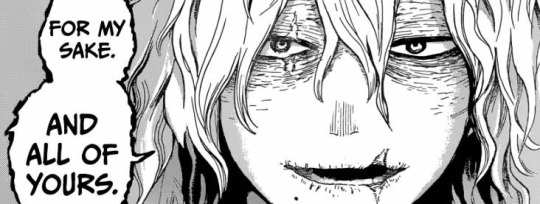
Himiko is also for the first time able to reach the emotions of another person. Remember when Himiko tries to explain how she’s feeling, she babbles, and babbles and nobody listens. However that changes and for the first time, not only does Himiko pick up exactly on what’s troubling Twice, she also comforts him the way he needs to be comforted. She tells him that yes it might be his fault that Magne died, but she sees that he’s doing his best to make up for it and she gently encourages him.
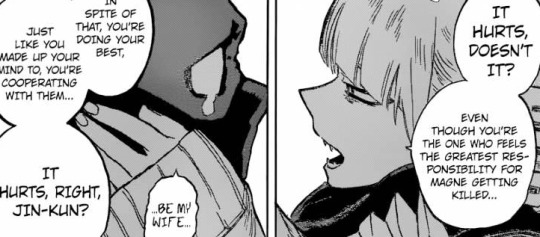
Remember how important this is for Twice. The world has never forgiven Jin for his mistakes. He hit the wrong guy on accident, while obeying the law, and lost both his job and his home. He started stealing to make ends meet, and as a result he lost his mind. When he makes a mistake it always blows up in his face but this time, Himiko notices that she’s panicking and comforts him telling him it’s okay he’s made this mistake and he can still work hard to fix it.

Not only that but she notices what the problem was with Jin, she was able to notice the symptoms of his psychotic breakdown and rather than dismiss it as just Twice being crazy was able to help him in real tangible ways by wrapping her hanky around him and covering him up like he asked. Uraraka has a very surface level kindness, she’s kind but only by walking around on eggshells with everyone. Himiko is able to see through people, but uses that to comfort people on a deeper level.
The “Himiko just can’t control herself because of her quirk” narrative is something that Himiko rejects herself. Because that’s not what Himiko wants. Himiko doesn’t want to be special or different from other people.
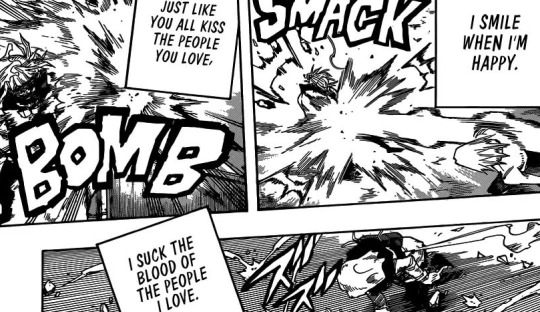
Himiko sees herself as normal, and what she desires to be understand and be understood by other people. She doesn’t like Curious’ narrative for her because it made her out to be a freak or someone special when Himiko is trying her best to get others to understand her as a normal girl. Himiko can’t repress herself anymore, she can’t become normal the way her parents taught her too so not permanently broken, and forced to always express herself she’s trying some other way.

What she wants isn’t to hurt other people, not really though. Those thoughts just turn violence, because Himiko is herself a person who’s endured a lot of violence. Himiko is basically a child that’s been on her own living on the streets and surviving for years, with all the dangers that entails, and also people who can shoot lasers and punch things really hard chasing after her.

The more she’s isolated and on the run, the more violence she endures, the more violent and unhinged her thoughts become. The more she’s exposed to people who accept her for who she is, the more she’s trusted by those people, the more empathic and sensitive Himiko becomes instead. Himiko’s desire isn’t violence, when she’s pushed to her utter limit she says what she wants is to become a girl like Uraraka who is just loved and trusted by others for who she is.
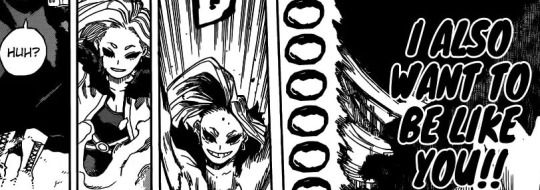

And I genuinely believe at the core of Himiko’s character this empathic girl exists. Himiko becoming violent and unrepressed doesn’t mean her empathy disappears. The complexity from Himiko is that she’s both the knife wielding psycho and the normal girl who just wants to have friends at the same time. If behind every normal person there’s a monster lurking is true then the opposite is true as well, behind every monster there’s a normal person.
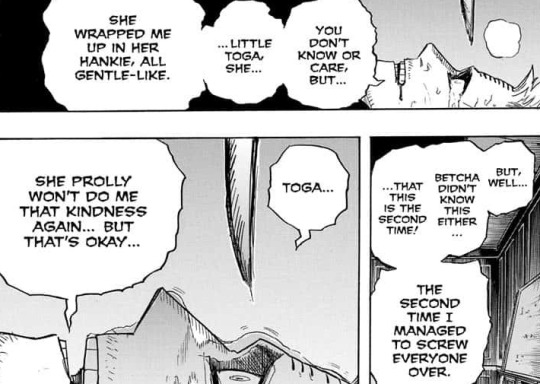
This is an idea expressed by Twice again. One of the villains that Hawks dismissed as a bad person, was capable of showing him compassion and gentleness even when he screwed up. Toga was capable of empathy for Twice besides the use he had for others. Toga herself is shown to be capable of more empathy than Hawks, who is one of the most selfless characters in the series, and who is convinced his actions are always done in order to save others.
However we see their treatment of Twice is so drastically different. Hawks treats Twice in a selfish way refusing to listen to what Twice wants, and only ever used Twice as a tool to exploit. Twice himself thinks that now that he’s no longer useful, Himiko won’t be kind to him anymore however we see the opposite.

Twice admits to Toga that he’s the reason that everyone is in danger right now and he completely failed, and he’s not going to come save them. He admits that he’s useless and Twice himself said Toga wouldn’t be kind to him anymore. However in that moment, Himiko ignores the fact that her life is literally in danger and everything is going to hell around her to comfort Twice one final time and tell him the words he needs to hear.
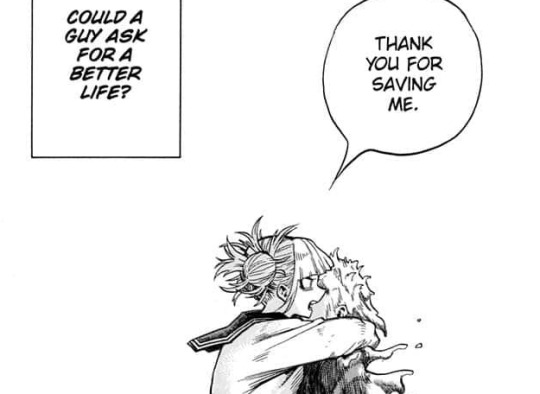
It’s literally the single most empathic moment of the manga, and it’s in direct contrast to Hawks’ behavior. A hero as devoted to saving other people as Hawks, who genuinely likes Twice as a friend doesn’t show him any empathy at all and even stabs him as the back. A psycho like Toga puts her own feelings aside and notices Twice’s feelings, and gives him comfort and thanks him in his final moment because to her Twice has value as a person beyond what his use is. That Himiko is capable of this kindness, but equally capable of her monstrous actions earlier in the series is what makes her human. Her kindness doesn’t make her any less mosntrous, and her monstrous qualities don’t make her kindness go away she’s both at once, rather than either or. That’s where the complexity comes in.
Toga is a very human character precisely because we see her at her most monstrous, and we see that girl slowly relearn how to express the kindness that’s always been inside of her in healthier non-stabby way. A normal girl who learned how to be a monster to protect herself. A monster who is slowly relearning to be a normal girl.
#himiko toga#jin bubaigawara#league of villains#league of villains meta#league of villains friendship#mha meta#my hero academia#my hero academia meta#my hero academia villains
633 notes
·
View notes
Text
How the Mighty Fall (in love) - (1/2)
Poppy x MC
words: 1,662
rating: m (swearing)
a/n: alright so as i’ve said in the sneak peak, i’m not a writer and when i do write, it’s rarely so bear with me. i had this idea concept of a confrontation between poppy and mc that happens in the bathroom while mc is being already late to kingsley’s class and poppy wants to have some fun with her.
i hope ya’ll enjoy
Sitting on the toilet and doing her thing, Bea looks around searching for any trace of vandalism. A graffiti here, a renaissance inspired dick drawing there and maybe even a letter plus another letter carved into the wooden bathroom stall - the ultimate modern symbol of love. All of the artistic things she had easily found in at her previous college and grown to love.
She zones back in as she hears someone enter the bathroom, stopping at the sink. Realizing she was done with her thing, she dresses back up and pushes the door open, exiting the stall.
And the person that stands in front of the mirror like on a fucking fashion show, is none other than the Bloody Mary herself. It makes Bea suppresses a shudder, as she approaches the sink.
"I wouldn't want to inhale radioactive particles emerging from your way, villager." Poppy states not even bothering to look at the other girl as she puts her fabulous cherry lip gloss on. Bea rolls her eyes at that, but moves to the next sink in the row. She does a small curtsy in Poppy's direction, which makes the blonde glance annoyingly at the girl's reflection in the mirror.
"Weren't those outlawed in the eighties for being totally lame? I mean, your whole look is so depressing. I may actually be dead right now." The Queen B points the tip of her lip gloss at the new girl's brown sneakers as she gestures at them.
Bea lets out a low hum of disappointment as she turns the faucet on and starts washing her hands, but doesn't ever bother to glance at the blonde.
Her lack of response brought a certain amount of impatience and displeasure on the shorter girl's face, as she taps her foot a few times disapprovingly against the bathroom floor. She checks herself out in the mirror as she starts speaking again.
"Everything about you screams pig mud. It's exhausting to look at you." Poppy pushes, continuing to delicately trace her lips using her favorite beauty weapon. Bea sighs as she finally gives in and pleases the girl with a remark and a question of her own.
"Do you ever get tired tearing other people down?" She prompts the blonde.
"No, not really." Poppy answers nonchalantly as she finally finishes putting her lip gloss on, not before letting out a small pop. There is a short-lived silence between them, until surprisingly Bea cuts the haunting but weirdly satisfying tension first.
"What, no oompa loompas in their Loubuttons following your spoiled ass around today?" Bea throws a curious glance over at the Queen B, wiping her hands with a paper towel nearby.
Poppy glares at the taller's girl reflection on the mirror, shoving the lip gloss in her handbag more hastily than intended. God, this woman infuriated her. Realizing that silence was her only answer, Bea continues pushing and the roles reverse, as they always do. She thrives on testing the other girl, knowing she is the only one who can put her back where she belongs. And it is beautiful and freeing - a great revelation in Bea's life.
"Are they finally aware of the fact that you sleep in a casket and live off the blood of villagers?
She smirks at the blonde after disposing the used paper towel in a trash can, never letting her gaze wander off of the other girl. Bea expects an answer - no, not an answer, more of a snarl, an animalistic growl. She certainly had a lot of training from all that yelling at the poor maids.
"Or maybe they're still chained up at the wall in your hidden dungeon." The new girl folds her arms over her chest as turns to fully face Poppy, lifting her left brow, "When do you take them out for a quick walk?"
This gets her attention, as Poppy turns almost too quickly around to finally lock eyes with Bea.
"Don't be jealous at the fact that I actually do have friends here. And your only known way of making them is snorkeling with Becky the cow in vicious, underhanded local gossip and rolling around in mud." She belts it out like a song and Bea lets herself chuckle at that, because how can she not at the bratty girl?
But the bratty girl doesn't plan on stopping there.
"Also that lame version of Janelle Monae girlfriend of yours is gonna drag your rep down like an anchor to the depths of Freaksville." Bea's sudden smug smile turned cold stare can cut Poppy's petite figure in half, as the blonde only snickers at that motion.
"I mean, how damaged does a girl have to be, to be into someone as annoying as you, Fetus Face." She snorts as she concludes her voiced thoughts.
This fucking girl, both of them think at the same time.
Bea continues staring at her as if she was analyzing a brilliant cut diamond, until she opens her mouth.
"Oh wow, pretty little liar isn't even aware of the fact that her minions don't see her as anything more than a self-proclaimed magnet for popularity and reputation based on levels of fear factor." Bea uncrosses her arms and starts waving her hands in the air as if she was demonstrating a rather unknown history fact to her class. Across from her, Poppy furrows her eyebrows down so hard luckily they don't combust on the girl's face right there.
"What the fuck are you babbling about, treasure trail? They're my friends, they listen to me, they care-" She tries to simultaneously stop Newbie from saying whatever next she had planned and anger-management her way through the girl's sarcastic tone and elaboration.
This time, Newbie doesn't plan on stopping herself.
"Do they really listen to you? Maybe your wallet more? Or maybe you offer some weird sexual fantasies equal to dark fetishes of a sloppy divorced businessman in exchange for a rank level up." She moves a step towards Poppy, who doesn't back down yet, even if she probably wants to vomit at the already close proximity between the two of them. Bea continues pushing, "Maybe the possibility of you throwing a hissy fit when it doesn't go your way which results in somehow expelling innocent students and your so called friends, lingers in their mind every time they look at you, Tinkerbitch."
Poppy seems distraugh as she looks at the brunette hesitantly.
Struck a nerve.
"You don't know what you're talking about, Lumps." She says finally through gritted teeth, after finishing stabbing Newbie with a stiletto in her mind.
Bea decides to do the ultimate move and get up all in the other girl's face as she moves yet another step forward. Now she is standing in front of her, the edges and tips of their clothes almost touching. Their faces inches away as they share the same breath, making Poppy's worst nightmare come true. And Bea's reveling in the feeling.
"Did I struck I nerve? Because make no mistake, Legally Blonde. Every time you open your bitchy mouth to shit on someone for no reason at all except your own dissatisfaction and low self-esteem, you take one step closer to everyone seeing that you are actually pathetic."
Bea doesn't smirk or smile this time after ending her sentence. She gazes down at the girl in front of her with a more sad kind of look. It's pity and Poppy can smell it, making her lower lip tremble in rage.
It takes all of mother nature's willpower and strength not the end the pig girl right in that moment, to take her by her disgusting lice infested curly brown hair and completely destroy her in the academy's meticulously clean bathroom. What a sad death that would be though. For the bathroom's tiles surface, not for the pigsty standing in front of her.
"First of all, your hideous sneakers are provoking me." She composes herself after snapping out of her thoughts, but doesn't back away, "Second, your mustache is thicker than Borat's", she throws a glance at the taller girl' lips and lingers a bit longer than intended before quickly looking up at Bea's eyes again, "so you might want to do something about that." She smiles proudly, thinking of how spot on that reference was on and Bea rolls her eyes at that.
"And third," the blonde continues, "you fucking rustic scarecrow, ship yourself back to Losertown or whatever sad country you came from. You don't know me and you don't know what you're talking about."
Bea doesn't say anything at that. Poppy celebrates her victory.
The taller girl stays mute as she just looks at her curiously for a bit, which unsettles Poppy as her stomach drops a little. Any kind. Then Bea does something that probably almost no one at Belvoire Academy dared to. She glances at the blonde strand of hair on Poppy's forehead that moved there while she was going all berserk with her speech. She casually grabs it between her fingers and softly tucks it behind the blonde's ear.
Poppy blushes uncontrollably at the action as they lock their gaze once again.
"Let me write you a reality check, Ritchy Bitch. Your two apostles? They don't give a fuck about you. Honestly, no one at this academy does." She ends it with a shrug and Poppy hisses, "You don't fucking know anything, you filthy skank." She almost spits at the brunette in front of her, boiling with frustration.
"Do you really think the foundation of a relationship is based on fear and disrespect? How fucking dense can you be?"
"I don't give a fuck about your free lessons on ho-" A hand covers her mouth suddenly which startles Poppy, but keeps her in her place as intended. Dark brown eyes appear even more closer than they were before, as Bea's face was inches apart from the blonde's own.
"I'm talking, shut up." Bea orders and Poppy complies.
—— —— —— —— ——
tagging people that wanted to be tagged and shamelessly tagging those who i think might enjoy this fic:
@uhh-the-green-thing @origmansello @ save-me-the-last-dance @ ognenniyvolk @ imdreamingof-you @ nias-missellarious @ uselesslesbianfr @ jkeiontheworks @somewillwin @kamilahtrash @poppysminion @captain-hanadeleine @simpforpoppy @poppysmc
also happy queen b day!
86 notes
·
View notes
Text
Review : The Tomorrow War (2021)

HBOMax and Netflix both had entries for the weekend of July 4, so it only makes sense that Amazon Prime would make sure that their presence was felt as well. After the swing at big budget glory that was Infinite, Amazon Prime’s recent science-fiction offering starring Mark Wahlberg, another big box office presence finds himself as the face of an Amazon production in the form of Chris Pratt, the household name whose fame grew after a stint in Parks & Rec and a star-making role as Peter Quill in the MCU’s Guardians of the Galaxy franchise. Based on the trailers, the film has all the trappings of a big budget, special effects and action-driven popcorn flick, so I decided to give it a shot.
youtube
If it weren’t for the deep science-fiction premise, The Tomorrow War could almost be mistaken as a commentary on the Military Industrial Complex, like an inverse take on the Starship Troopers approach. Watching Dan Forestor instantly transform from a teacher and family man into his former war-hardened soldier form feels noble in terms of its intent, and maybe it’s just the cynic in me, but it immediately puts a coldness on the entire future war affair, as if pure detachment is needed to survive a threat that draftees are given zero time to comprehend. The fact that a worldwide draft is implemented to subdue a universal threat is oddly timely for the conspiracy theorist in me, especially in light of the fact that there seems to be an interesting sea change on the horizon in regard to the political stance on public knowledge of extraterrestrial existence. Even with this otherworldly threat standing as antagonist, the film doesn’t hesitate to play on the beat that having the enemy emerge from within is a strong possibility. Despite the way that I’ve rambled about this particular spectrum of The Tomorrow War, Chris McKay and company balance these threads quite well, and all while ramping up the energy and momentum of the film from story beat to story beat.
With Infinite standing as Amazon Prime’s other attempt at rolling out a blockbuster (as previously mentioned), one can garner that a fascination with time-based narratives is becoming a common thread. The Tomorrow War borrows the best aspects of the Terminator franchise and Shane Carouth’s Primer approach to build its framework, which allows the logic needed for this particular suspension of belief to be sold due to concepts that seems easy to explain at face value, but above the head of standard comprehension upon reflection. For example, the acknowledgement of the generational gap that would exist between the young military force from 30 years in the future and the middle-aged draftees helps us dispel the worry for potential time paradoxes due to meeting yourself in the future, but it also sets up a slight John Connor mythos once you realize the Forestor father and daughter relationship will boomerang back and forth through time, at least from Dan’s point of view. Positioning time as fluid and always moving allows McKay and company to implement the fixed point theory of time travel, which instantly raises the stakes of the story due to the built-in ticking clock that comes from making sure you don’t miss your return window. With these two foundational points strongly set, a sort of narrative tuned mass damper is built which allows you to stack all types of realistic and imaginary science on top of what the audience has already accepted.
There seems to always be some sort of indistinguishable gap between the historic big budget releases in theaters and the small sample serving of streaming service attempts, but The Tomorrow War is a huge step in closing that gap when it comes to production value. Viewers will immediately notice the impressive use of effects for both the time travel and the Whitespikes, and when we are given moments to view the post-apocalyptic world, it is stylized enough to have an emotional impact. The combat is appealing to watch, much like the previously mentioned Starship Troopers, as a good mix of novice, survivalist and pure military approaches are mixed in among our characters, with as much adaptive learning being present as there are unfortunate casualties. There are a number of powerful allusions to Vietnam present in the film, such as the use of choppers and air strikes, the post-traumatic stress and shattered worldview of returning soldiers, deserters, and much more. The overall tone of despair and danger weighs heavily on the film, and using unconditional familial love as the driving force of hope rather than traditional romantic love is a nice change of pace.
Chris Pratt does what he does best, mixing his natural charm, humor and ability to symbolically and literally gather the troops in his role as the leading man of The Tomorrow War, while also being one of the most believable members of the combat force. Edwin Hodge matches Pratt’s intensity in terms of combat while providing an edge that stands in opposition to Pratt’s warmth, which makes them a formidable dynamic duo. Yvonne Strahovski manages to present a façade of military leadership to mask a clearly volatile presence of love that must be held in check in order to make sure her mission is successful, which echoes the adoration shown by Ryan Kiera Armstrong in her role as the younger Muri Forestor. Betty Gilpin remains hopeful (and even mentally sharp) in the face of a threat that would cause many similar characters to go to pieces and play their characters as fragile, one-note worried housewives. Sam Richardson provides a solid mixture of comic relief and scientific knowledge, which is welcome within the midst of a very heavy soldier presence that dominates the film, giving the average viewer someone they can latch on to. J.K. Simmons makes a couple of notable appearances (I wouldn’t mind seeing him work with Chris Pratt again in the future), while Jasmine Mathews, Keith Powers, an interestingly cast Mary Lynn Rajskub, Mike Mitchell and Seth Scenall round out the supporting cast.
The Tomorrow War reminds me of my time working at the movie theater back when I was in high school, specifically the summer that Independence Day was released. I’m not saying that McKay has found that Roland Emmerich magic, but he has managed to match the spectacle of Independence Day in a way that modern day audiences can relate to. If streaming services can match the quality of films like The Tomorrow War moving forward, I may have to stop mentioning the movies in a light that makes them sound lower tier.
#ChiefDoomsday#DOOMonFILM#ChrisMcKay#TheTomorrowWar#ChrisPratt#YvonneStrahovski#JKSimmons#BettyGilpin#SamRichardson#EdwinHodge#JasmineMathews#KeithPowers#MaryLynnRajskub#MikeMitchell#SethScenall
2 notes
·
View notes
Text
Beyond the Road: Pilot
001 “Pilot” Written by Eric Kripke Directed by David Nutter
Plot Summary
In 1983, Mary Winchester was pinned to the ceiling of her sons bedroom and murdered. Twenty two years later her sons, Dean and Sam are reunited after several years apart when their father goes missing. They follow him to the town of Jericho where a string of men have vanished and though their father is nowhere to be found, the brothers continue the investigation which leads them to a stretch of highway and the local mystery that surrounds it.
Sam
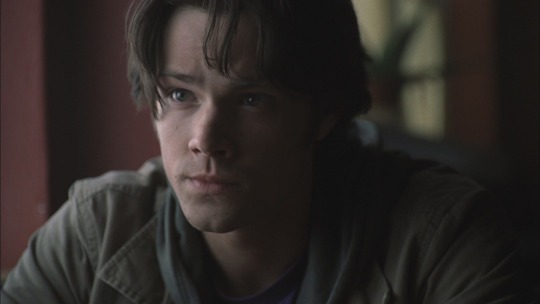
Normal vs Safe. A good chunk of this episode is dedicated to highlighting Sam’s decision to leave the supernatural behind him and try for a safe life. He makes the distinction between ‘normal’ and ‘safe’ when Dean accuses him of running. He doesn’t think he can have a normal life. This is an issue Sam will struggle with for the whole series, going all the way up to 15x16. In this episode however, he argues that his life isn’t normal but he wants a safe life. He doesn’t want a life where he is constantly looking over his shoulder but he won’t ignore danger. We get a glimpse of this when Dean breaks into the apartment - Sam can clearly still fight. In contrast to this, we do see Sam’s aversion to anything reminiscent of the supernatural such as Halloween. He doesn’t want to think about it as he doesn’t see how it could possibly live alongside the life he has chosen for himself.
Branching off of this, I wanted to make note of a distinction between Sam and Dean and their worldviews. As Sam and Dean leave the apartment they talk harshly about the way they were raised. Sam claims that they were “raised like warriors”. He talks about how, when he was scared of the ‘monster’ in his closet John gave him a weapon. He views this as something that shouldn’t have happened - that John should have told him not to be scared. Dean argues against this but it starts to become clear that Sam can only see the horror in the hunter lifestyle. This is a contention Sam and Dean will return to in the next episode and elsewhere in the series. Sam is only able to, at this point, see the negatives of a hunter lifestyle.
Sam’s resistant to the way he and Dean were raised, but an interesting idea begins to form during their argument on the bridge. Sam doesn’t see John’s revenge plan as something he is part of, unlike Dean. He doesn’t want to avenge Mary as he doesn’t remember her. He is very unsympathetic about John’s revenge plan which, I think it’s safe to say, stems from that manner in which he was raised. He was dragged around the country and his own life seemingly put on pause so John could hunt and get revenge. Sam has far more self-preservation than Dean and puts his own life over revenge. This is a theme that will come up again and again during the show.
Something else that I noticed during my rewatch was Sam listening to Jess’s messages in John’s motel room. He listens to her messages but doesn’t actually talk to her. In fact, during his time in Jericho, we never see Sam call Jess. The only person he attempts to communicate with is Dean. He will listen to her stories but doesn’t contribute anything himself. Just like their pasts; Jess has, as far as we are aware of, been honest and open to Sam about herself. Sam, on the otherhand, is keeping so many secrets from her that it comes across as a rather unequal partnership.
Dean
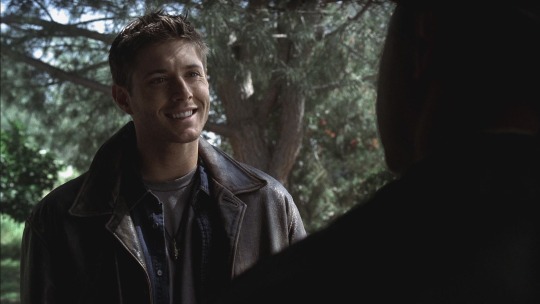
First thing to note for Dean is the Original Trauma of Supernatural; Dean carrying his brother out of the burning house. This has been talked about… everywhere. I felt like I still had to mention it and how this is the base layer of Dean’s personality and something that is embedded in his sense of self-worth. I also wanted to make note of how this continues through to the show through to 15x10. Dean is put in charge of looking after Sam and so much of his life is structured around his role as Sam’s protector. This affects other relationships in Dean’s life as he struggles to put Sam down long enough for himself to pursue anything or anyone not directly linked to hunting or Sam. This is something he will eventually grow out of by the time we get to 15x10.
There’s something else that has never really occurred to me but Dean probably relates so strongly to victims of the week because he himself was a victim of a supernatural attack. Sam doesn’t remember the night Mary died and doesn’t let it rule his life but for Dean that night changed his whole world. I’ve never quite made that connection until now but, as we’ll see starting the very next episode, Dean is more empathetic to victims than Sam is and it possibly stems from this.
Okay, about Dean flirting with Jess. Obviously, at the very start of the series Dean is meant to be portrayed rather less thoughtfully than what Jensen actually did so this could be brushed aside as the writers just wanting to make Dean a fuckboy but this kind of behaviour does show up again later in the series but with more baggage tied to it. Dean flirts automatically. He makes cheeky comments laden with sexual innuendo all the time, including later in this episode to the police. It’s possible that he just finds this the easiest way to make a connection without actually opening himself up too much. Also, in recent years he has lost both Cassie and Lee so this flirting, which actually worked to distance Jess more, may have been a way of keeping out anyone he considered an “outsider” because the last two he let in didn’t stay.
Something else that was interesting about Dean’s thoughts on Jess is something I only really noted on this recent watch; he doesn’t think her relationship with Sam is healthy because Sam is lying to her. For someone who lies for a living Dean struggles to lie to people he cares about, especially people he enters relationships with. At this point Dean’s two biggest relationships have been with Lee, another hunter who worked with Dean and understood the life, and Cassie, who Dean told all about hunting and monsters and subsequently lost. As the series progresses Dean will have a serious relationship with Lisa who learns about monsters and hunting. His relationship with Cas becomes fraught when Cas lies to him in s6 and honesty becomes a central aspect of their bond, with telling the truth becoming the major story arc for their characters.
The last point I want to make about Dean is about the bridge fight between the brothers. Dean says that Sam has “a responsibility” to their father which Sam scoffs at. In reality, Dean is the one who has tied himself to John out of a sense of duty. This line reads to me like Dean projecting onto Sam, something he will do again during the series. Dean is the one who tied himself to the family revenge crusade and his anger at Sam here hints at his own anger about his situation. This is something that will rear its head later on in the series.
Mary
The opening scene became more painful the longer the series went on for. From being sad about a family being torn apart to being sad about the loss of Sam and Dean’s mother and childhood innocence we can now see the scene from Mary’s point of view. Having lost her own childhood and parents to the supernatural Mary’s desire to run and live a normal life is understandable. In that manner, Sam is like her though unlike Sam, the price of running was paid by Mary and not an innocent bystander. The two deaths bookend the episode but also suggest a theme of continuing the cycle.
Mary vs Constance. I’ve written about the parallels of Mary and Constance here. I do have one thing I wanted to add to this and that is something that occurs on the bridge during the brothers fight. Sam and Dean argue about Mary culminating in Dean shoving Sam against the bridge’s railing and that is when Constance appears. Symbolically Constance represents the ghost of Mary, haunting the boys even after all these years. She is summoned as they invoke her name, wearing a similar nightgown to what Mary died in. The death of Mary had a major effect on the boys and this episode begins to hint at it though we won’t see it fully realised until her return much later in the series.
“Angels are watching over you”. I know, I know. It wasn’t technically said in this episode but as it is confirmed in s2 that these were Mary’s last words to Dean I think I’m safe to talk about it. I won’t say a lot yet but this line does tie Cas into the original trauma of the show if only as the representation of the faith that Dean would learn to trust after having given up because of this trauma. Mary’s faith is something that became tainted in Dean’s eyes after she died. He never had the same faith that Sam did because of this until an angel proved himself to Dean. This imagery comes full circle in s12 when Cas does save Mary in 12x12 but more on that later.
The Story
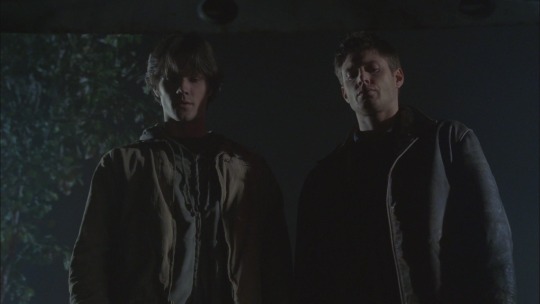
So the episode itself is primarily linked to Mary’s death and the Trauma of the Winchester Family. It does set the characters up for their journeys moving forward as well though. The story is ultimately dominated by the brother, of course, learning to be brothers again. When the show started Sam was intended to be the main character while Dean was a supporting character. During the episode we start with Sam and don’t get much insight into Dean as a character. Knowing what happens in the rest of the series really highlights how Sam truly didn’t know his brother as well as he thought he did. Or rather, Dean managed to keep a lot of things from his brother. One of the most infamous moments is, of course, Dean’s “no chick flick moments” comment. This is something Sam will learn to see through later but in this episode he seems to take it at face value along with many other aspects of Dean.
One other thing to mention about the plot of the episode itself. One of those is the destruction of the Welch family due to the mothers actions. She acted out of intense pain and betrayal but her actions do lead to her children suffering. This theme not only pertains to the Winchester family (Mary, Dean and Sam) but also to Sam, Dean and Jack in s14. This kind of familial pain returns, again, in s15.
And with that we have 1x01 in the bag. Next week we’re off to Blackwater Ridge in 1x02 Wendigo.
Men of Letters Library
The initial summary of 1x01 The original pitch for the first five episodes The original promo for 1x01 1x01 podcast episode by @season14podcast A meta post on 1x01 with 14x20 in mind by @mittensmorgul
#spnbtr#spn 1x01#winchester family dynamics#spn thoughts#dean winchester#sam winchester#mary winchester
2 notes
·
View notes
Text
Some thoughts on The Caligula Effect 2
So I joke about this game getting a second remake to my friends online and the next moment I learn THIS was announced during the Japanese Nintendo Direct. Let me spill out my thoughts to spark discussion as well as provide a record to myself if this game actually does get localized.
Everything is under the cut!
My thoughts on Overdose were that it has a fantastic world... and that’s it. Out of the game’s cast, there were maybe four characters I liked, and the rest had moments that made me lose all sympathy for them. I recall it was common for some Let’s Players to like the villains better than the protagonists, and I’d agree on that front. I actually think the anime is the best iteration of this game’s story, changing up the formula enough to provide a really solid characterization arc to everyone. But Overdose suffers from poor writing issues (killing Eiji offscreen in the best ending was one of the worst decisions they made), rough handling of certain topics, boring and monotonous dungeons, and 500 social links you’re never going to do. I’m incredibly critical of this game, and I’d never recommend it to someone without a LOT of disclaimers, but somehow I still love it.

Already this game looks CRAZY good visually. It doesn’t look like a reskinned Vita game anymore, with something a little more reminiscent of say, the Digimon Story Cyber Sleuth games. That’s not to say that the game doesn’t still implement its fantastic character art, which still show up next to the speech bubbles. (At least the models have moving jaws. That’s important.)
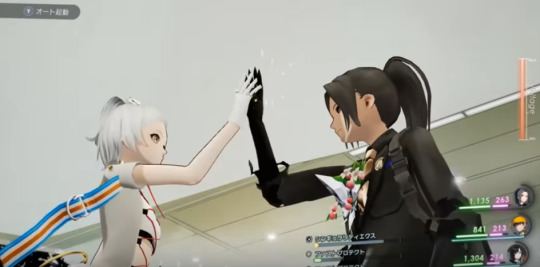
Here’s to really hoping this game won’t be another Caligula 1 reskin, because uh... the game is about a protagonist who realizes that the world is a virtual one created by a Vocaloid who won’t let anyone out and joins up with a group of teenagers who also want to get out despite the fact that their real world lives were horrible so that they can set things right and they call themselves the Go-Home club (and also a Vocaloid gives them weapons made out of black stuff) but the people that are stopping them are basically the servants and guardians of the Vocaloid keeping them trapped in, who also happen to be humans who can’t return to the real world because their real world lives were so horrible, and so they have to fight because the Vocaloid won’t let them out otherwise. I mean, of course it won’t be a reskin, but I’m surprised at just how much of the original story they kept.
As for things they absolutely did NOT keep, DAMN this game looks dark! I was once remarking to a friend about how Caligula’s story would appeal better to me specifically if they’d gone with a religious pressure rather than idol stan theme, and they appear to have really pulled through with that religious pressure. I just realized, while writing this, that the image I showed off above actually has an image of an angel in the stained glass window being worshiped by fans with glow sticks. Furthermore, there’s a gothic cathedral-like altar, a halo behind Regret’s head, and this whole exchange looks like it takes place in a church. While I’m not religious myself, I can talk a lot about church architecture (see: my Fire Force livetweet) and I’m interested to see how this game handles it.
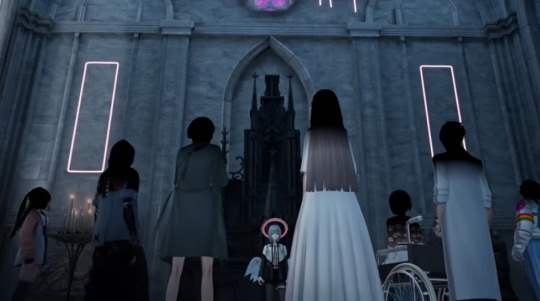

Not only that, most of the character designs seem darker and very different from the original game’s. Take a look at this game’s idol goddess:
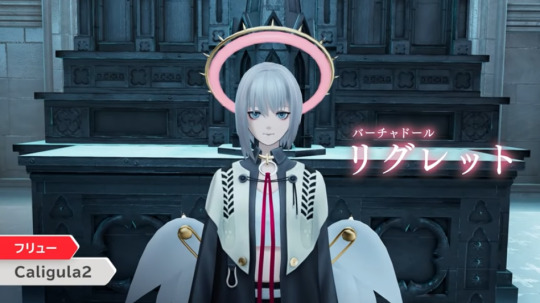
Is μ going through an emo phase? I wouldn’t blame her lol. I think she still has a fantastic design that is in equal parts dreary and beautiful, while perfectly matching the color scheme of the new game.
And what a color scheme it is! The world of Caligula 1 had a gorgeous white, black, pink, brown, and gray color scheme framing bold pops of color in the form of flowers. Caligula 2 changes things up by making black the primary color framing everything else. The pops of color are so much bolder, too, from Noto’s bright yellow sweatshirt to basically everything χ is wearing. Do these changes reflect the story’s potential darker tone too? Or are they representative of something else?
We don’t know too much about the characters, but Caligula 2 looks like it’s giving them different weapons. It looks like the protagonists wield double knives instead of double shotguns. As for the other weapons, I see shortswords, katanas, chains, pistols (much smaller than Shogo’s), canes, and Qiyana’s ohmlatl from League of Legends. Definitely a shift from the original game’s weapons. I wonder if they’ll make a comeback? That giant gun was unique to say the least.
The Obbligato (I think?) are this game’s Ostinato Musicians. Italian for “obliged”, they are the ones who defend Regret from any threats. The one shown off most in the trailer is this guy who looks like the 1010 dudes from No Straight Roads. Man, he really looks like Shadow Knife in that image up there...
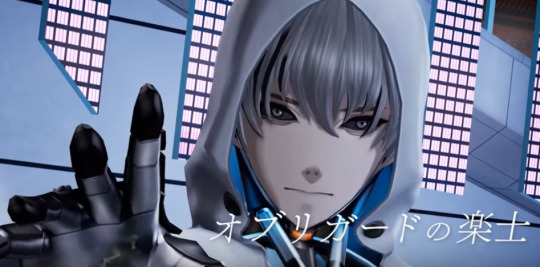
Also we get a, um, clown astronaut and a crazy high school yandere. Just to name a few. Definitely not the first time I’ve beat up a clown in a video game. Pretty unique as far as villains go, though. I hope this game has its own villain route, where you learn more about them. I’d really like that.
Social links! Looks like you rank up social links the same way you do in the original game. Do you want to make this character spill out all their trauma? Are you SURE about that, despite there being no negative consequences to you, the player? Awesome. Get ready to be sad.
The battle system is, from what I’ve read, similar, but not the same, as the battle system in Overdose. I’m not going to give too many details on that. They still seem to be time-based with combo chains, but they’re pretty vague. Looks like you still get to unleash crazy special attacks against your enemies. And they in turn can unleash crazy special attacks against you.
I absolutely want to see a. better characters and b. better overall writing. In my opinion these were the two weakest points of Caligula 1. Despite the protagonists’ tragedies, some of the little things they did made me sort of hate them. I did not like how everyone in the original Go-Home Club used Kotaro (who you learn is FOURTEEN!) as a verbal punching bag despite him being one of the kindest characters in the club. As for better overall writing, I stated before that I preferred the anime’s interpretation of events, because I thought they were in a better order overall. Besides killing Eiji offscreen, I hated how they wrote μ to be such a monumentally stupid character (I often point to Persona 5 Royal on how to write a villain like her well) and their, in my opinion, poor handling of certain topics like fatphobia. And though the character episodes sort of redeem them, it’s like... not really? The way I described it to a friend was that while the moral of Caligula 1′s story may have been “We live in a society and everyone’s dealing with their own hardships, but you can’t run away from them forever and you can at least be sympathetic to those facing them”, the character interactions end up dumbing it down to “We live in a society”.
Also an anime adaptation would be really sick. The anime just had so much better writing.
As for what I’m really curious about:
1. Who is Regret and how is she related to μ and Aria? We already know she’s a Virtuadoll like them, but if I recall correctly μ and Aria had some more concreteness to their backstories. Specifically, the human characters remember them existing as vocal synthesizer programs before they became the rules of Mobius. Regret’s backstory is that she just kind of showed up one day. Does she have different origins from μ and Aria? By the same merit, who is χ and how is she related to Regret, μ, and Aria? We know that χ opposes Regret and gives the Go-Home club the power to fight back against her, kind of like what Aria did in Caligula 1, but was she a co-creator of Redo like Aria was, or was her role completely different? The fact that she isn’t a little sparkle like Aria was (as a result of losing all of her power) indicates that their roles might be a little different.
2. What relationship does Redo have to Mobius? We know Mobius was created because Aria and μ wanted a place for humans to live without the sorrows they experienced in the real world. However, eventually μ was manipulated by everyone’s negative emotions and Thorn’s actions. This caused her to prevent anyone from leaving, and also the plot of the first game. Is Redo a second, improved iteration of Mobius, or a completely new virtual space? Were the goals behind its creation the same as in the first game? Or was there another force at work? Is Regret trying to copy μ or improve on her work? Or is she doing what μ did independently? I don’t think there’s enough information to predict the answer to this, but from what I’ve seen, there are a lot of similarities between the two worlds, from the high school to the end goal. However, there are some differences in tone. Mobius was a place to escape suffering, while Redo is being marketed as a place to escape regret. Redo also has a more religious bend than the idol theme of the first game.
3. What other links do the first and second games have to each other? People have been theorizing that Marie Mizuguchi/Wicked from the first game may return as Marie Amabuki (I think) in the second due to them having the same VA. There’s obviously the shared artstyle, symbolism, Catharsis Effect, glitchy NPC faces, and general setting. I also suspect that this game takes place after the events of Caligula 1. Not much I can say about this right now, but I wonder how everything joins up. Or if it even matters that they do. I haven’t seen too much on whether or not this game is being marketed as a standalone or a sequel, or if you even need to play Caligula 1 to enjoy Caligula 2.
Conclusion: While the Caligula series isn’t one I’d recommend to everyone, for the way it handles a number of sensitive topics, I will still be checking out Caligula 2 if it comes to the West. Though very little has been revealed thus far, so far I’m interested in the religious iconography used as well as the darker tone and colors presented in the game. As well as the characters, who have more varied and interesting designs including super unique weapons. I’m a bit disappointed that the plot, as it has been revealed, is an exact copy of Caligula 1′s plot, right down to the names of the protagonists’ faction. I was hoping for a bigger evolution to the story, but considering so little has been revealed in the first place, this may be a bit of a preemptive judgement.
That’s it. I hope you enjoyed my discussion of what I’ve learned so far.
1 note
·
View note
Photo

The Dragon Painter (1919)
Asian-Americans are often sidelined in Hollywood, whether they appear in front of or behind a camera. So when the exceptions come along, there is a tendency to label that actor, director, or writer (or whatever their role is) as – to put it bluntly – as representing all Asian-Americans. I do not know if actor Sessue Hayakawa ever felt that public burden during the peak of his popularity during the silent era, and I hope he never did. During the 1910s and early ‘20s, Hayakawa was a legitimate Hollywood leading man and a sex symbol – the sort of actor that will, on a rainy day and with a sizable puddle of water between the vehicle he is exiting and the sidewalk, have women willingly throw their coats onto that puddle to assure him safe passage. Yes, that story is real.
Many of Hayakawa’s silent films are now lost and the ones that are extant are either difficult to find (sitting in a vault with obscure/nonexistent home media distribution) or in poor public domain quality (though much credit has to be given to the Library of Congress’ National Film Registry for their restoration work). The subject of this piece is The Dragon Painter, directed by William Worthington and released by Haworth Pictures – Haworth was jointly owned by Hayakawa and Worthington and is pronounced by combining the first syllables in their surnames. Haworth was Hayakawa’s outlet to make films that avoided the damaging Asian stereotypes found throughout American filmmaking in the silent era. But as for cultural fidelity to Asian stories, values, and aesthetics, The Dragon Painter feels as if Hayakawa – who shines in the film with a ferocious performance – and Worthington are compromising that fidelity to appeal to general American audiences.
High in the Japanese mountains lives the painter Tatsu (Hayakawa), who spends his days gazing across picturesque landscapes, his hair unkempt, fixated on his artwork. Tatsu’s sanity is not clearly established, as he believes the gods have taken custody of his fiancée, a dragon princess. In Tokyo, the elderly painter Kano Indara (Edward Peil, Sr. in dreadful yellowface) is seeking a student, having dismissed many candidates over the years. One of Indara’s friends, Uchida (Toyo Fujita), stumbles upon the eccentric Tatsu and his paintings. Despite Tatsu’s untamed behavior, Uchida believes Tatsu has the artistry to be Indara’s heir. Thus, he invites Tatsu to Tokyo by claiming he knows the location of the missing princess. Tatsu, of course, follows. Once the backwoods painter arrives in Tokyo, he causes a ruckus at his own welcoming dinner but is calmed as Indara’s daughter, Ume-ko (Tsuru Aoki), poses as the dragon princess and performs a dance. They marry soon after, but their marital status comes at the expense of his painting abilities.
With many outdoor scenes filmed in Yosemite National Park in California, I – as someone with a casual appreciation for the history of the United States’ National Park Service – found myself utterly distracted by the view of numerous iconic features of the park that appear in the film. In the film’s first half, the constant backdrops of Yosemite Valley by cinematographer Frank D. Williams (a then-former chief cinematographer at Keystone Studios, with a credit in The Little Tramp’s debut in 1914’s Kid Auto Races at Venice) challenged my ability to take The Dragon Painter’s claim of representing an “authentic” Japan seriously. Worthington, seeking a sumptuous location, plays up the film’s geographic and cultural Orientalism. The installation of a torii gate in the middle of the Merced River and a Japanese village surrounded by flora that could only be found in Northern California is laughable today. Somehow, The Dragon Painter escaped such criticisms upon its release. But Yosemite, as a United States national park (and the place where the idea of national parks was born), was less than thirty years old in 1918. Generally, in America in the 1910s, there was far less knowledge about the national parks system, even about one of the crown jewels of the National Park Service. Today, with greater knowledge about at the parks nationwide, the film’s backdrops make less sense given one of the film’s central goals to depict Japanese culture.
The film’s cultural Orientalism is no better. With a white director, white screenwriter (Richard Schayer), and based on a novel written by a white woman (Mary McNeil Fenollosa), The Dragon Painter could deviate from its source material – even a minor change or two – to minimize its inaccurate cultural depictions. Worthington and Schayer decline that option. Indara’s household is filled with an aesthetically busy, incoherent, and period-clashing hodgepodge of Japanese art. Ink paintings, sculptures, and other works. It is a legacy of Japonisme, a French term on the popularity of Japanese art in the late nineteenth century following the nation’s forced reopening of trade.
The Dragon Painter goes even further than its set decorations and costume design as the film posits that in order to restore Tatsu’s artistic abilities after his marriage to Ume-ko, Ume-ko must sacrifice herself for him. That development should raise skeptical eyebrows, as no one should lay down their lives for someone else’s art – and predictably, the person who must perform the sacrifice is a woman in love. This angle of a Japanese woman killing herself makes The Dragon Painter, in its second half, a Madama Butterfly narrative. It is not known if Worthington or Schayer were influenced by Giacomo Puccini’s opera and John Luther Long’s short story (neither Puccini nor Long ever visited Japan), but the movie’s depiction of an obedient (if not subservient) wife that will even consider extreme practices to salvage her husband’s career comes from an inauthentic place. Contrast this depiction of a woman to the one in Kenji Mizoguchi’s The Story of the Last Chrysanthemums (1939, Japan), where Kakuko Mori’s life-straining altruism – and numerous female characters in dire straits found across Mizoguchi’s filmography – was based on Mizoguchi’s close relation to his older sister. Unlike Worthington, Mizoguchi frames his film of female sacrifice from the personal, rather than something offhand.
If Hayakawa intended to distance himself from the stereotypical, vehemently racist portrayal of Asians at the major Hollywood studios of the silent era, those intentions are constrained by the financial and production-related realities of The Dragon Painter. Though his and Aoki’s performances are satisfactory, the fact that Edward Peil, Sr. appears in yellowface as Indara contradicts Hayakawa’s goals. How much power Hayakawa had over The Dragon Painter’s production is an open question (as well as how he felt about the final product), but if Hayakawa wished to portray Japanese culture as faithfully as possible, he must have been disappointed at the results. In the 1910s, tension between the Japanese-American community and Hayakawa’s image – exotified romantic roles that nevertheless kept some distance from white women characters – precipitated into the creation of Haworth and Hayakawa’s promises to make films with less problematic Asian depictions. This tension – which also existed with Japanese moviegoers who saw Hayakawa as too Westernized – is almost never mentioned today, as Hayakawa’s reputation has been subject to hagiography for being the lone Asian leading man of silent era American cinema.
For Hayakawa, clashes with his film distributor, economic recession, and the State of California debating the prohibition of property ownership by resident of Japanese descent forced him to leave the United States for Europe, only to return to Hollywood sporadically for the remaining decades of his life. The Dragon Painter, once presumed lost, was rediscovered when a print was unearthed in France. In 1988, a joint restoration effort by the American Film Institute, George Eastman House, and New York City’s Museum of Modern Art brought renewed attention to the film. Six years ago, The Dragon Painter – as one of Hayakawa’s few existing films – was inducted in the Library of Congress’ National Film Registry, deemed a national treasure, and marked for preservation for posterity.
I have spent most of this review dragging The Dragon Painter through the mud of my reservations and criticism, but I appreciate the film as a rare example of a leading Asian-American actor and actress (Hayakawa and Aoki were married) given top billing in a Hollywood film. For that reason alone, it deserves to remembered and appreciated in all its representational imperfections.
My rating: 6/10
^ Based on my personal imdb rating. Half-points are always rounded down. My interpretation of that ratings system can be found at http://dweemeister.tumblr.com/ratings_system (as of July 1, 2020, tumblr is not allowing certain links to appear on tag pages, so I apologize for the clunky spelling-out of the URLs).
For more of my reviews tagged “My Movie Odyssey”, they can be found at https://dweemeister.tumblr.com/tagged/My-Movie-Odyssey.
#The Dragon Painter#William Worthington#Sessue Hayakawa#Tsuru Aoki#silent film#Toyo Fujita#Edward Pell Sr.#Frank D. Williams#Richard Schayer#Mary McNeil Fenollosa#TCM#My Movie Odyssey
17 notes
·
View notes
Text
15x05: How to Fight God
Proverbs 17:3 --> The crucible for silver, the furnace for gold, but the Lord tests the heart.
This proverb really gets to me when looking at it in the light of 15x05, but also when looking at how it relates itself to the series as a whole, because our boys are going through nothing short of a trial by fire, their whole world and sense of self is beginning to take flame and that sounds poetic af, but it’s also so fucking poignant that I can’t even.
Because isn’t this what their whole journey has been? And what it’s been about, too, meaning that the trial by fire serves an actual purpose, the get rid of the impurities (if you will) while the actual trial isn’t by fire, but lies truly in the aftermath, in the lessons and the learning curve: the heart stuff.
That aside, of course, applied to 15x05 it’s quite literally God testing their hearts - and what they’re really made of - by throwing them a proper curve ball in Lilith, not to mention this revealing the fact that he’s still a presence.
We open on Sam, who’s checking his phone to see if Cas has finally replied to all the concerned texts Sam has sent him (my heart leaped I loved it so much!) (of course Sam wouldn’t not reach out) (and amazing that Cas literally decided then and there to walk out the door and he just removed himself entirely) (also - poor Sam!) (he lost a friend!!) and Cas hasn’t gotten back to him.
Buuuut!
Cut to the end of the episode and Sam is just hanging up from having an actual conversation with Cas. Sorry, this was me remembering this entirely wrong and not double-checking - it went straight to voicemail and is clearly stated as doing so, pls, ignore my ignorance!
There’s still a nice, subtle bookend here, and it still underscores the change we get from the opening scene to the closing: the brothers both believing they’re back to business as usual (with the difference of how now they’re actually holding the reins) vs. realising God isn’t gone and that the status quo is not something they can fall back on here.
Speaking of the status quo, the way things have always been, the saving people, hunting things, family business side to the brothers’ lives that is, as far as they’re concerned, the cornerstone of their identities... yeah, let’s speak of that for a bit, because if we look at the episode I believe the status quo, or perhaps the repeat patterns, is/are actually the answer to the question Dean finishes the episode with:
How do we fight God?
So then.
How To Fight God
This is basically speculation based in my meta reading of the episode so pinches of salt, loves, but it’s intriguing to me to think about what the rules of this world actually are, because this is GOD the CREATOR, right? Yeah.
How can you, the puppet, defeat your puppet master when your puppet master determines which of your strings are pulled at any given moment?
Well, firstly, I’m stuck on the exchange between Dean and Cas from 15x02:
Cas: You don’t think I’m angry? After what Chuck did? After what he took from me? He killed Jack. But that doesn’t mean it was all a lie. [...] Even if we didn’t know that all of the challenges that we face were born of Chuck’s machinations, how would we describe it all? We’d call it life, because that’s precisely what life is. It’s an obstacle course. And maybe Chuck designed the obstacles, but we ran our own race, we made our own moves, and mostly we did well with that. Dean: Did we? I’ll tell you what we do know - nothing about our lives is real. Everything that we’ve lost, everything that we are, is because of Chuck. So maybe you can stick your head back in the sand, maybe you can pretend that we actually had a choice... I can’t. Cas: Dean. You asked what about all this is real -- we are.
I mean technically Dean didn’t ask anything, he stated that nothing about their lives is real but alright I get that you want to break through, Cas, because this is Cas trying to make Dean understand that not everything has been pre-determined by Chuck.
If free will didn’t exist at all in the narrative, then there would be no room for any kind of stakes, emotional or otherwise.
If it didn’t come down to what choices each situation brought about and the lessons derived from the consequences of those choices, then the meaning of the character journeys would be completely nullified.
And these rules of the world we’re watching are most clearly demonstrated to us in the S14 season finale, when Dean makes that epic choice of not shooting Jack, effectively ripping up Chuck’s perfect ending and forcing him to go all mental deity on a power trip on all of their asses.
So Cas is clearly right in the above exchange, but Dean can’t hear it, and because Dean just refuses to listen, Cas sees no other choice but to leave in 15x03. Because all Cas can see is how Dean refuses to let go of old patterns of thinking, old hang ups and fears, and how Dean finds refuge in blaming an external source rather than gaining perspective, accepting his own level of responsibility (in any situation) and moving forward.
I’m very curious about the prayer and what level of exposition it will entail. Imagine it being an actual callback to the confession scene in S11, where the exposition of Dean’s internal struggles with his longing for more is so beautifully balanced. Anyway, digression.
What I’m getting at is that choices seem to play an enormous part here, and of course they should, because that’s one of the most prominent thematic threads the writers can pull on.
Our choices make us who we are.
It’s not what you are, but what you do.
No one can tell you who you are, you choose who to be.
And along these, all the times we’ve heard I didn’t have a choice. Often this has been true, when put in a situation that is about not only saving each other, but the world itself as well, but then those world-saving situations wouldn’t really have been brought about if Dean, that first time Sam died, hadn’t made the choice (echoing Mary) to sell his soul to save him, and, of course, none of the choices would’ve been necessary if Mary had let John die, but we know the world that would’ve brought about, so thank...... fate for bad choices.
Perhaps it’s time for good ones.
How do you fight God?
I think you fight him by breaking old patterns, and the only way you can break them is by recognising them for what they are and truly, definitively, moving out of them and into new ones.
Chuck represents the writer not keeping up with their own character’s progression, right? He’s not seeing what this world he’s created has actually become, without his influence. All he sees is what he wants it to be, rather than all that it is, and he believes in his own control to the extent of not adjusting the obstacles he’s throwing at the boys to their ever evolving view of themselves and what they want for themselves.
Which is why the plot point of Dean being seduced by Lilith wasn’t even hinted at until she stated, in dialogue, that apparently it wasn’t happening. Thanks to Dean’s progression away from who he was way back when, yeah? Not exactly the same, are you, Dean?
And which is why I believe the moment when Sam says-->
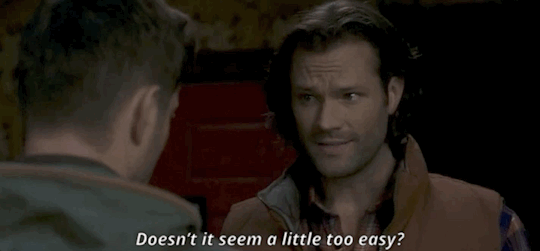
--> is quite possibly crucial, because Sam can see the pattern, he knows the grooves of it so well that he immediately feels something is off when they’re just handed the solution on a platter, and this hunch proves right, because they know how Chuck’s story works, innately, they’ve lived it for over a decade.
If they can catch up with this fact, if they can begin to use it to their advantage, that would be very cool. If they begin to go against their old mode of being, if they try to think outside of their own box (as it were), then not only is that a viable way of beating Chuck at his own game, it sets the stage for their final leg of character progression rather beautifully.
Because it forces them to grow wholly self-aware, to question their choices and weigh the pros and cons. Realisation City.
And how gorgeous then to have the setup be that to survive and have a healthy sense of control over their own lives, they must evolve away from their old ideas and ideals. *fingers crossed*
And then there’s Chuck as representative of the over-arching shadow, representative of all those things that the boys have battled throughout their journey, and if integration is the goal, then Chuck shouldn’t really be reaped by Billie, should he? I mean, him being reaped by a representative of strong, assertive femininity works on a symbolic level as well, but integration could mean that he simply has his power stripped.
I’d quite like that, to be honest. The way to fight God is to stop worshipping him, stop believing in what he represents, stop allowing his obstacles to be real obstacles and simply move out of the narrative he’s been telling and into a new one, where his chosen ending makes absolutely no sense. And if Jack returns there may be a player with enough power to actually tell God that his time as ruler of this particular universe is done, because they will fight him, now that they see him for what he truly is. Every step of the way.
Alright, lots of speculation here, but the thought of the brothers’ progression actually playing a role in how they can defeat Chuck makes me get all goosebump-y!
The werewolf brothers acted as a Chuck tool of foreshadowing for his chosen ending: one brother killing the other, but there’s a deeper psychological symbology in the werewolf brothers’ story, where one brother’s control and deceit made the other see no other choice but to kill him and then himself, because they were the same.
So looking at them as representative of the codependency, it’s actually the aspect of control and self-deceit that has to die, in both Sam and Dean, for the codependency to finally break. Sam leading the way (as per the water bottle scene at the start of the episode) and freeing them both in his process of breaking away from Dean.
And when Lilith says that she had to die in order to get what she wanted, it could be seen as a statement of that same symbolic subtext, and how the brothers’ progression is moving them away from who they have always been, into who they truly are and want to be: they have to kill off their past ideas and ideals, and embrace the truth of this if they’re going to be victorious in this fight.
We shall see, my loves! We shall see!
I’d be remiss if I didn’t say this, though, to a writer who has given us so much:
Thank you, Steve Yockey.
For everything.
#<3#spn meta#spn 15x05#character progression#dean winchester#sam winchester#codependency#breaking the codependency#symbology#chuck#how to fight god
65 notes
·
View notes
Note
How did you decide on the daemons you did for the Bennet sisters?
Oh that’s something that takes some answering, thank you :D. I tend to pick and choose between religious and heraldic symbolism, cultural associations, puns, but I’ve got a bunch of loose ground rules that narrow things down based on age, social standing, gender, etc — it depends on the character. Starting with broad strokes:
Aristocrats and their families really pride themselves on big-cat daemons, which neatly ties up: Darcy and his cheetah daemon; Lord Asriel and Stelmaria; and the long and storied history of British monarchs representing themselves /the state with lion symbolism.
Following from that, the more important you (think) you are, the larger and more baroque your daemon tends to be. In Mr Bennet’s case, his bear daemon is so large as to be practically disabling, since the accomodations necessarily required to manage his lifestyle are barely within budget (story of Mr Bennet’s life), but he’s also someone who has social power and doesn’t use it.
The enlightenment arguments about concepts of the self as an individual distinct from the society it springs from, and the interest in the scientific community in exploration in classification that were happening at about this time should clash in the public imagination with more old-fashioned heraldic concepts of what it means to have your inner self on display. And, while I had a lot of issues with The Secret Commonwealth, I did think it was interesting that Pullman suggested people mostly knew what animal their daemon looked like, and that’s something take into account at a time when your average person would not be expected to be widely informed on the fauna outside their own home region. So some people are very traditional and conformist (the Fitzwilliams), some people try to game the system on their or their children’s behalf (Jane, to an extent), some would prefer to see the whole thing stripped of artifice or otherwise romanticise the idea of more instinctive and naturalistic (Darcy very much, Elizabeth slightly less so), some don’t think too much about it and just go with the flow (Charlotte).
Witches and magicians (almost) always have bird daemons, per HDM and also because of the consistent association of birds with magic in JS&MN, particularly ravens. So Jonathan Strange has a blue jay daemon, because blue jays are corvids but they don’t look it, and Strange is a very good magician but tends not to look it on on introduction.On the other end of the size scale, Mrs Bennet’s dalmatian pelican daemon is springs from catholic imagery in which pelicans are symbolic of self-sacrificing motherhood, based on a medieval belief that pelicans pecked their chests bloody to feed their chicks with their own blood. Since this is absolutely not true of pelican behaviour, and since pelicans in life (enormous, smelly, loud) are much less romantic and attractive than that imagery suggests , I figure it works both with what Mrs Bennet would like to believe about herself and how she actually is.
Which necessarily leads to the Bennet girls all having bird daemons, conveniently narrowing the field of possibilities.
For Jane, whose daemon is a hyacinth macaw, I wanted a tension between outward conformity to the role of perfect daughter and gentlewoman, and someone who has hidden depths. Bright bird daemons are very much in vogue for ladies — think parrots and birds of paradise — so she fits that mould, with an elegant and beautiful daemon; but on the other hand hyacinth macaws are much bigger, cleverer and more powerful than your average parrot, they’re less immediately eye-catching and surprisingly good at camouflaging themselves. They’re also (by parrot standards) relatively patient, even-tempered and shy, and they pair-bond quite strongly in addition to being generally social, but they can be destructive when they’re unhappy, and Jane, I think, quietly excels at self-destruction. The backstory that may or may not make it into the fic itself was that Jane spent a lot of time in her mid-teens being dragged around town to every menagerie and museum Mrs Bennet could manage to get tickets to, mostly without Elizabeth, feeling miserably shy and self-conscious because people kept staring at her. She saw a very lonely macaw (via a Portuguese trader Uncle Gardiner knew) trying unsuccessfully to hide from massive crowds in a showy display, and felt a sort of immediate empathy with it which, erm, stuck.
For Elizabeth, whose daemon is a gyrfalcon and, unlike Jane, a complete accident, I riffed a bit off Darcy. So, something fast (and, importantly, faster than a cheetah), independent and aggressive, but also beautiful, playful and charming — archness and sweetness, you know? Gyrfalcons are beautiful and quite acrobatic, and (pun incoming) their scientific name (falco rusticolus) means countryside dweller. They’re endemic to both England and the arctic areas that the witches are associated with, suiting Elizabeth and her interest in her foreign grandmother. They’ve also got a long association with the uppermost echelons of society, being the valued possession of kings and generally a mark of high honour to associate with in any capacity. (Darcy, whose family still regard themselves basically as vassals of the Raven King, absolutely knows what a gyrfalcon looks like and what it implies, but unfortunately rushed to judgement too soon. He’s in for a hard time sorrynotsorry)
For Mary, (short-eared owl), an owl was the obvious choice, given the association with seeking wisdom, if not necessarily finding it — I admit to a bit of petty amusement at the way owls are not, in fact, particularly bright birds, despite their reputations. Barn owls and snowy owls, while lovely, are just super over-done, and for Mary I wanted something little bit silly, too big and too drab in his colouring to be fashionable, but not fierce enough to command admiration. I figured by this point in their parenting career Mr&Mrs Bennet had moved on from dragging the girls around town, and what encouragement they got to consider the wonders of the natural world consisted of being pointed at the door and told not to come inside until dinner, maybe a new book of illustrated plates if Mr Bennet thought it was interesting enough to buy. Short-eared owls are pretty commonplace in huge parts of the world, including the UK, so it’s quite likely that Mary would have come across them even with limited resources.
For Kitty, I admit that I don’t have a sub-species quite nailed — he’s a pink hummingbird, but that’s colouration rather than a specific type (possibly a bronze-tailed comet or a red-tailed comet). He’s pretty, tiny, silly and annoying, (‘for heaven’s sake stop buzzing about at breakfast! My poor nerves, etc etc’), which seemed a natural fit for Kitty. However, hummingbirds are also associated with the souls of dead warriors in Aztec mythology (although admittedly my knowledge in that field is woefully thin), and as Kitty has a fair bit of fight in her and absolutely no ability to pick her battles, her daemon would naturally be the sort of animal that starts fights they have absolutely no ability to win.
As for Lydia, well — she’s still working it out, in her own special way.
19 notes
·
View notes
Text
The Gods of Witchcraft
When I got involved in Wicca, I found that most of my teachers emphasized the Goddess. Many people have been raised with traditions that emphasized the male aspect of divinity. These same people often come to nature-based religions with a desire to reconnect their spirit to the divine feminine, the Mother principle. I know I did. I came from a strict Catholic background, so I found the idea of the Goddess both intriguing and comforting. I always liked the Virgin Mary, and found the multifaceted images of the Goddess quite a wonderful challenge. It was hard to look at the feminine as not only virgin mother, but also sexual mother, warrior, crone, witch, healer, and reaper. Though it was a challenge, I found a building a relationship with the God to be an altogether a different experience.
Though many people think Wicca and Witchcraft are only about the Goddess, the God plays a pivotal role in most traditions. Most groups celebrate the union of Goddess and God. And while many emphasize the Goddess, and some exclude the God all together, most will look to both the Goddess and God of Witchcraft. Wicca and Witchcraft are traditions of balance, of both masculine and feminine energies. Practitioners are encouraged to recognize and develop both.
I had always had the image of God being a bearded man in the sky—distant and remote, ready to punish us at anytime. I read a lot of the Old Testament in Catholic School. Intellectually, I understood that God as a creative force, but this image was what I had for a personification. When I learned about the Witch's God, I got some very different images. Sometimes they were frightening, other times fatherly. Some were remote sky figures, others were earthly and sexual.
The God can be seen with three faces, much like the Goddess, but he has two dominant aspects. In fact, the God, is often strictly described as a dual god—a god of light and of darkness. The light god rules the waxing half of the year from Winter Solstice to Summer Solstice. The light god is sometimes called the Oak King. The dark god rules the waning half of the year from Summer to Winter Solstice. In Celtic traditions, the dark god is the Holly King. The Oak King and Holly King are said to fight at each solstice for control of the year. The Green and Red Knight legends, in which one battles the other, can be seen as a variation on this myth.
Light Gods
Sun King: The Sun king starts as a small child at the Winter Solstice, but is associated with a mature man by Summer Solstice. Most Pagan traditions look to the Sun as male while the Moon is female, and associate the growing light with waxing God.
Green Man: During spring, the God takes on an emerald hue, as the light of the Sun is photosynthesized in the green of the land. This God is one of vegetation, of the forest and the plants. Many believe the Green Man faces depicted in European churches were part of an effort by Pagan craftsman to keep Pagan traditions alive while the Church was in control.
Sacrificed God: The Green God or Solar God is brought to a peak of power and then sacrificed on or after the solstice. This God is associated with the harvest of either grains or fruits such as grapes. When the harvest is cut, the waxing god is done and yields his power to the dark half. The sacrificed god is the light god with the darkest aspects because he represents the transition from one side to the next.
Sky Father: The Sky Father image is one of either the benevolent father, or the distant patriarch. The figure of Zeus is probably the most well-known Sky Father from Pagan mythology. The Sky Father doesn’t partake in the light/dark cycle in the same way as the gods described above, but rather is the father figure who gives birth to the Sun God/Sacrificed God.
Dark Gods
Horned God: The Horned God, from the Greek Pan to the Celtic Cernunnos, is the most beloved and misunderstood image of the Witch's God. He is the animal lord—a fertility god and the guardian of the gates between life and death. The Horned God was long ago corrupted into a fearsome image, but gods of horn were well loved throughout the world before the advent of Christianity.
Underworld King: The Underworld King or Lord of the Dead is found in many mythologies, ruling over the unseen kingdom of the ancestors. Some, like Pluto, are also gods who rule over the riches of the underworld, making them patrons of wealth as well.
Sea King: Many traditions look to the ocean as the underworld, or one gateway to it. The Sea King is not necessarily a dark figure. But, esoterically, water deals with the emotional realm. So does the underworld. This creates the link between these two kingly archetypes. In Roman mythology, Pluto and Neptune, Gods of the Seas, are brothers.
War God: The Warrior Gods are not necessarily dark or underworld gods, but they are associated with some of the darker emotions we feel—including fear and anger. The true warrior path is one of discipline and courage, and some of these gods can teach the skills necessary to become a spiritual warrior.
Many gods don’t fit either the light or dark aspect. They are neither waxing nor waning forces. These gods are the male archetypal beings of the places in between. They are the bridge between the light and the dark. They are connective force. In myths, they often act as either guides to the gods, or instigators of their problems. They are the gods who are magicians and tricksters. Figures such as Hermes, Mercury, Thoth, Anubis, Odin, Loki, Gwydion, and Merlin would find their home in the places in between.
Meditation on the God
Get comfortable and set the mood for this meditation. Light some candles and incense. Sit in a comfortable position. Think of your intention to connect with the energy of the God, in whatever form he takes. Take a moment and ask for guidance and aid from your spirit guides and higher self. If feel connected to a particular form of the God, ask that aspect of the God to be present with you.
Close your eyes and count backwards from twelve to one. Twelve is a solar number, and associated with the god force. Imagine yourself before a tall hill or small mountain. See, feel, sense, and know that the hill is there. It's OK if you can't visualize things clearly. Just imagine it and go with your impressions. Sense that the hill of the Gods is there, and it will be.
Its height is a challenge, but not insurmountable. There is a pathway that guides you up, winding around the hill. Follow the pathway up. Climb higher and higher, taking notice of any rocks, plants, or animals that you encounter on your way. Each can be a sign for your journey. Certain stones can act as future talismans for you to work with this god. Plants may be in harmony with his energy, and help you reconnect. Animals can act as a guide or totem for you to return, and symbolize your connection to the God.
When you get to the top, you might find the God waiting for you on the summit. If you are meeting with a light god, or even an in-between god, he will usually meet you on the top of the hill and have a conversation with you, or guide you on a journey. Use your intuition and have confidence in your first impressions. Trust yourself, and trust your experience with the God. Let his words and pictures enter your consciousness effortlessly.
Or you might find a barrow, an opening that leads inside the hill, as if the hill was secretly a cavern, with a winding tunnel leading to its heart. There waiting for you in the center will be the dark god, in one of his many forms. He will speak with you and share his inner-world mysteries. Again, use your intuition and follow your first impressions. Open your heart to feel his message, in addition to processing it mentally. The dark god teaches on many levels.
When done, thank the God for whatever the experience was. Sometimes it is loving and gentle. Other times, it might force us to see things that we don't wish to, but need to witness for our own growth. (I know the God has been both for me.)
Return down the path and come back the way you entered. Retrace your footsteps. Do you see any of the same stones, plants, or animals? Take note of the ones that feature prominently in your perception. When you reach your starting point, count up from one to twelve and ground yourself. Open our eyes, stretch, and eat a little something if you need to. Write down your experience in a journal.
Many think the Goddess is always loving and gentle while the God is a stern taskmaster. But many times I've found the reverse is true. Simply let go of your expectations and know that the God is equally available to you in your path of spiritual development. He is simply waiting to be asked into your life.
===================
By Christopher Penczak. (d) 2005 Llewellyn Publishing Ltd. All rights reserved. Originally published in The Llewellyn Journal.
from All Wicca Store Magickal Supplies http://www.allwicca.com/index.php?route=news/article&news_id=114
2 notes
·
View notes
Text
Lilith’s Appearance Post-Season 2
She will always appear as Ms Wardwell. And this is for the following reasons and headcanons, and what I establish as canon for my blog/my Lilith:
While we have seen, throughout the series, Lilith use glamours-- appearing as the Tarot Lady, as Edward etc-- with Ms Wardwell, it’s not a glamour. She kills the woman, before casting a spell and drawing symbols in her blood. It is neither possession or glamour: it’s something else entirely. Talking with my Mum of all people, we came to the conclusion, that as Lilith was instructed to sneak in amongst Sabrina and her friends-- being the serpent beneath the flower so to speak-- this blood spell was about physically taking on Mary’s appearance, not the mere illusion of it, not the possession of, but flesh, blood and bone (the fact we see her take out her own rib without shaking off Mary’s appearance nicely supports this headcanon). Blood and sigils are all about binding, so this spell is binding Lilith to Mary Wardwell’s image, her body. By this reasoning, Lilith no longer looks like her original self (the original young, ingenue looking Lilith we see at the beginning of the episode and in flashbacks) but instead looks like Ms Wardwell. Permanently (further support of this could be taken by the fact she doesn’t change her appearance back as she steps into hell at the end)
At this point in the storyline, the very first episode, Lilith has no wavering loyalty to Satan, she is willing to do anything for him, we see the lengths she’ll go for him, and that would include physically changing her appearance for his purpose, and Lilith could easily reason that amongst the denizens of hell, power matters more than appearance. But, as we see later on, looks do matter because Satan is obsessed with becoming his handsome self again. And we now know he never intended to make Lilith Queen, but was going to crown Sabrina. He never tells Lilith this, but by sending her to become Wardwell, to deliberately make her change her appearance, permanently making her appear the older woman, the archetype of the mother/teacher rather than bride/queen, while Sabrina is the pretty young ingenue now, as Lilith once was, it is a subtle way of Lucifer controlling and demeaning Lilith, exerting his power over her, belittling her role, before she even realised he was doing anything.
The reason I am having this theory as canon on this blog is because not only does it display how loyal Lilith was to him (and nicely serves as another example of Lilith sacrificing parts of herself in this abusive relationship), it emphasises the refrain of how looks matter to men, even Lucifer the fallen angel, and how the patriarchy are obsessed with how women look and place their worth based on that. Older women are shoved to the side in favour of young, prettier models, and through this canon, Satan does this in a very literal manner. He had already put Lilith in the ‘supporting role’ and ‘Satanic Fairy Godmother’ (two phrases she uses herself), but by her having Wardwell’s appearance, has physically put in those roles too.
Yet, considering it’s looking this way that she took the crown for herself, allied with other women to defeat Satan and confine him, it could be that the thing Lucifer intended as a clever prison to her ‘supporting role’ turned out to be the thing that gave her the chance to take the power for herself.
21 notes
·
View notes
Link
I first spoke with Dianic Priestess Ruth Barrett about how to create a Samhain ritual, which you can check out HERE. In part 2, we get into the roots of radical feminism.
AfterEllen: I wanted to talk to you about lesbian feminists embrace of Dianic spirituality. In the 1970s a lot of women turned away from the religions in which they grew up, because they identified them as patriarchal, and they turned instead to a new women-focused spirituality.
Ruth Barrett: I want to name one of our foremothers Mary Daly, feminist theologian, she languaged for many of us the realization that as long as god is male, the male is god. It was one of those took-your-breath-away paradigms that was hiding in plain sight. So for a lot of us in the 1970s-80s the notion of ‘how do we recognize spirituality, religion, politics? and how does patriarchy affect all of these things?’
There was this examination that continues to this day. As your readers know, our lives don’t take place in a vacuum, they are always in a context of history or herstory.
In the 1970s as women were working primarily for equal pay, reproductive rights, equity in the workplace, all of those things, the notion of a feminist spirituality did not enter the consciousness for some time. That had to do with the fact that Marxist politics was influential on the left. Religion was the opium of the people. Spirituality was a distraction from the work people needed to do to be free. It wasn’t until the latter half of the 1970s that women started to think about it differently.
Z Budapest is a Hungarian-born immigrant who came over after the communists had invaded Budapest, and she brought with her her mother’s folk traditions, folk religion. She also became a feminist, so she began to merge these two things.
Around 1976 or ’77 she was arrested for fortune telling in LA, it was against the law. It was the witch trial that occurred in LA in that year. That got the attention of the feminist movement of the time. They had struck out against that woman for tarot reading. The movement took notice and things really went well from there. It was a spiritual revolution. The idea of ‘where do we oppress ourselves from the inside?’
This is what I came up in in my teens and early 20s. Where are we complicit and colluding with the values of patriarchy that we have been indoctrinated into?
AE: You had mentioned the witch trial of Z Budapest
RB: The “Year of the Woman,” let me point out.
AE: Was Z a lesbian?
RB: Yes, and she still is (laughs).
AE: So the movement takes up the cause of women’s spirituality. There was a fair amount of denigration of women’s spirituality within the movement I imagine, in the same way there was the denigration of the “Lavender Menace.”
RB: Many women did not embrace the idea of a feminist spirituality. You have generational trauma over patriarchal religion and rather than seeing it as something that could be healing, there was an outright rejection. There was a lot of Eastern influence and New Age thinking that entered goddess spirituality as well. The Dianic tradition was based in radical feminism, but the larger goddess movement was not necessarily. It really depended on who feminists ran into, in terms of what they could relate to.
I founded a community in Los Angeles; I was ordained in 1980 and that community is still going. It’s the longest running Dianic community. The work that we do is not only personal, it’s political. We do work to counter the dominant power in the best ways we can. We work to heal from the effects. To model the way we want to see the world, through our activism.
It’s because we came out of Second Wave feminist politics. Those who identify in the Dianic tradition still have some form of political activism in terms of their magic and their rituals.
The Dianic tradition — in the beginning most of us were lesbian — but it grew and is now not specifically lesbian. A lot of people assume it’s a lesbian religion, but it’s not. It’s for any female who identifies with those values of radical feminism.
AE: Oftentimes patriarchal loyalists and people who want to denigrate older women make the claim that crusty, old, privileged, white women bought into Dianic traditions or goddess traditions because they buy into gender essentialism. Can you speak to that?
RB: Well there’s a lot of goddess traditions, so there may be a seed of truth regarding some of those traditions. But let’s look specifically at Dianic tradition. Gender essentialism is a misunderstanding coming from the fact that Dianics focus on the sexed body as a metaphor for life. Gender is arbitrary designations of behaviors or characteristics ascribed to the body, whether you are female or male. The women that come to Circle are very diverse in their presentation. It was not just women in flowing robes that were participating, then or now. There were women who were not conforming to gender roles. Essentialism is put on goddess traditions, but Dianics don’t focus on a [gendered] duality. When you don’t focus on a duality, you don’t have the issue of genderism [the gender binary]. In the Dianic tradition, we are whole unto our selves. We model wholeness, so it’s not like females have this one set of characteristics and males have the other. It means we have it all. I can wield the sword and I can cook a meal. Whatever would be gendered behaviors or skill sets — it’s not like, because I have this body I’m more this or more that “naturally.”
That’s what’s happening now because of trans/gender ideology. At the same time people think we’re getting away from the binary, we’re actually reinforcing it. Essentialism means I’m a sexed female, therefore I’m more prone to these attributes and of course these characteristics are gendered. And Dianics just out and out reject that. Who made this up and whose cause does it serve? Where did we get this notion that we have a male side and a female side? What they’re saying with the duality of [masculine or feminine] behaviors or attributes is a crock, we are all whole.
Women can be and behave and aspire to whatever we want and the only thing stopping us is cultural conditioning. That’s the opposite of essentialism.
AE: So Dianism puts forth that there is no single way to be a female.
RB: The maiden/mother/crone metaphor is just a way to talk about our lives. The maiden is youth, mother includes warrior, amazon, creatrix, and crone is the woman who is elderly. Phases of life like the inhale of woman’s breath, you sustain that breath for a moment, then you exhale. It’s a way of talking about cycles. Creation, sustenance and death. So there’s many ways we use language to talk about it and the women-centered symbols is another way to talk about that.
AE: There has been an explosion of women returning to personal practice, a mainstreaming of witchcraft. To the point that there was a witch starter pack that was going to be sold at Sephora.
RB: It may be an entry point for women. You can’t see me rolling my eyes right now, but I also want to think, “what could be positive about this?” The backlash reveals the idea that power in the hands of women is inherently evil. In a sense to normalize it, to do divination or turning inward for guidance, the idea that we could assist one another in our healing — that’s not a new idea, that’s an old idea. Becoming commercialized may trivialize it, but it also means that this idea is no longer terrifying to women to consider their own power or their own authority.
AE: But this might be the first spark for a woman to turn inward for guidance. There is a wide commodification of witchcraft and ethnic and folk traditions going on right now, certainly Sephora is the worst example of trivializing and feminizing since it is part of the multi-billion dollar makeup industry. It is also happening on Etsy and Instagram from boutique sellers. But it’s so interesting that this came from a makeup store since this is one way that women participate in our own feminization and conformity to gendered stereotypes.
RB: It’s also interesting that there’s this thread in magic of “glamoring” and that has to do with influencing others to see you in a certain way. So I hate the stuff, but I’ve put on mascara or something knowing that if I do it with perfect application, I’ll be treated in a certain way.
AE: As a feminine-of-center lesbian, I don’t want to denigrate makeup-wearers, and I definitely wear makeup sometimes, but it’s so true that in liberal feminism the party line is that enacting gender stereotypes can be empowering.
RB: In liberal feminism, anything goes. There is no consistent analysis.
Glamoring, the definition is the quality of fascinating alluring or attracting. Glamoring, in magical terms, can be a charm, enchantment, or witchery. Glamoring is taken from the intentional creation of an illusion.
105 notes
·
View notes